
Foreword: British amphibious warfare in WW2
D-Day was retrospectively the most visible amphibious operation of WW2, but in this game the British were by far the most experienced of the allies, starting operations in the Mediterranean as far as 1940. As we commemorate today Operation Overlord and the 2,700 British lives spent on the beach of Normandy that fateful 6 June 1944, 946 Canadians (for 4,413 total over 156,000 that landed total that day and cumulated in the next waves), it is time to also remember those that were in between the frontline beaches and the fleet: Landing Crafts and landing ships crews.
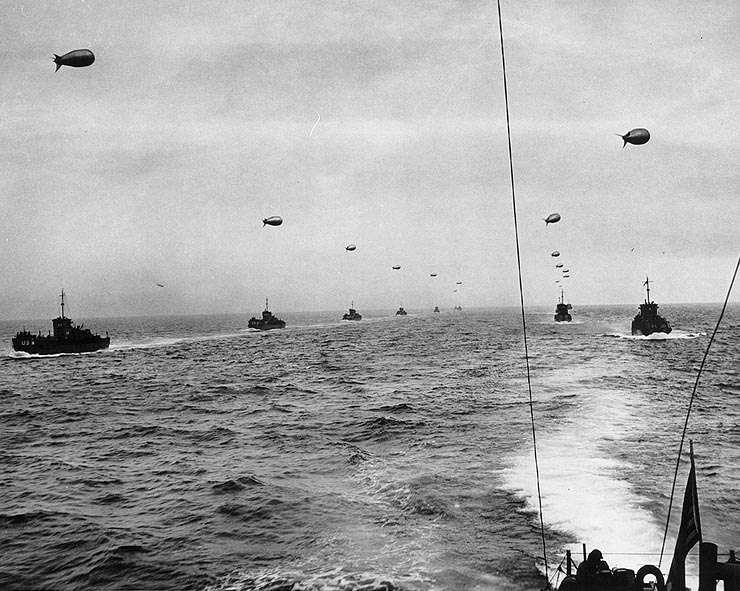
The allied Armada on June 6, 1944
The British massed thousands of such vessels over a grand total of 6039 vessels of the Armada. If most of them were built prior to the operation, the British Royal Navy had experimented with the idea of amphibious warfare right from the Dardanelles campaign in 1915. Before that, and the few modified ships for the task, troops -in particular Marine troops, the famous Royal Marines, usually used the onboard yawls and small boats to land from tall-ships (the latter conveniently providing fire cover). After the failure of the operation, another in the Baltic was planned by Lord admiral J. Fisher in order to cut the rear of German lines, but which never materialized. Also, the Battle of Bita Paka and Tanga were forgotten 1914 operations against German outposts in the Pacific.
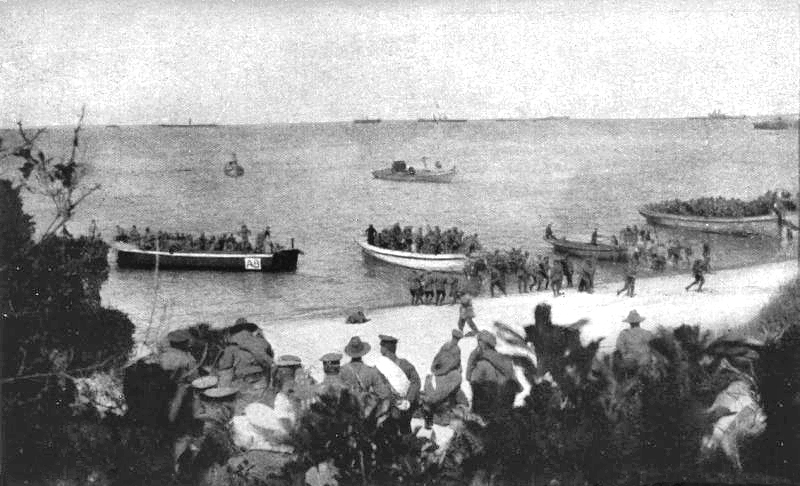
X-Lighters in Anzac Cove, 1915.
In WW2, the British and commonwealth Forces participated in about a hundred operations round the world, most small in scope, and assimilated to Commando Operations, such as the Zeebruge raid in 1918. We are going to dive in light detail in all of these*, and next, study what landing crafts and ships were used.
*Each will be covered by a dedicated post in the future.
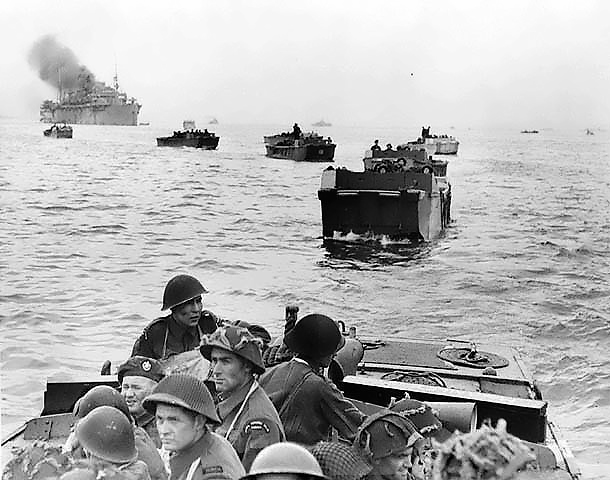
The Canadians lands at Juno beach
British Commonwealth Amphibious Operations in WW2
Operation Abstention – February 1941
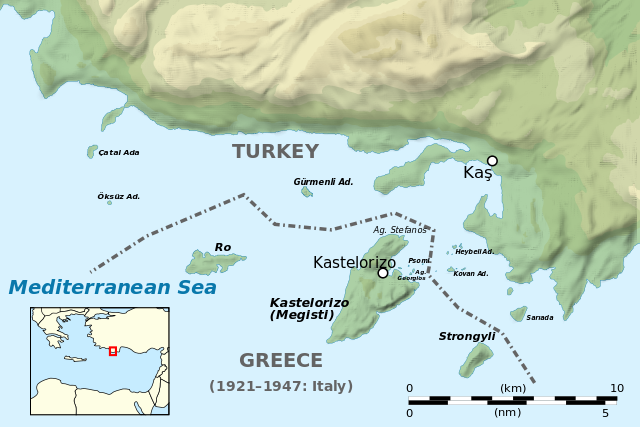
This almost forgotten operation of WW2 saw one of the earliest landing in the Mediterranean. It was a British invasion of Kastelorizo (Castellorizo), an Italian-occupied island off the Turkish Aegean coast in the night of 27-28 February 1941. The idea was to install a base to contest the waters of the Aegean to the Italians, notably British MTBs were to be placed there.
The British forces were commanded by E. de F. Renouf and later H. J. Egerton, under overall supervision by Andrew Cunningham. This was a small scale operation, comando-like. The landing force comprised 200 commandos for the first wave, reinforced by 200 marine troops and Australian soldiers.
The convoy comprised the light cruiser HMAS Perth and HMS Bonaventure, escorted by 7 destroyers, the gunboat HMS Ladybird (which carried the marine troops), while the commandos themselves were carried by the destroyers HMS Decoy and Hereward. They came from the western areas of Suday Bay and south from Cyprus. It started on 24 February. The forced gathered and launched the first raid at Nifti Point before dawn on the 25. The path and support was prepared by submarine HMS Parthian, arrived earlier. During the whole operation, troops arrived directly on land (MAS) or disembarked while paddling, using boats and rafts.
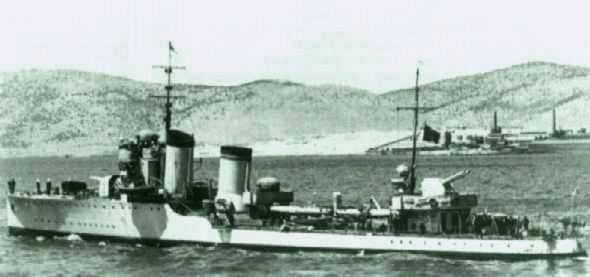
The Italian destroyer RN Crispi
The Italian garrison was soon overrun but had the time to send a message to naval HQ Rhodes. The Regia Marina sailed all night and on 26, counter-attacked in force with the torpedo boats Lupo and Lince landing about 240 soldiers. Later Luigi Biancheri launched another attack with more troops carried by the same two TBs and in addition MAS 546 and MAS 561 on 27 February. The fight intensified, and worsened as eventually the destroyers Crispi and Sella launched another landing later this day.
This day and the following, confusion installed itself in the area, and the Sherwood Foresters company jumped onboard a ship. On the 28, despite reinforcements from Alexandria, Italian forces in the Island were back in strength and total confusion turned to a rout, whereas HMS Jaguar duelled with Crispi. In the end, this was a tactical defeat for Uk, Cunningham adding it was “a rotten business and reflected little credit to everyone“.
Operation Chariot – 28 March 1942
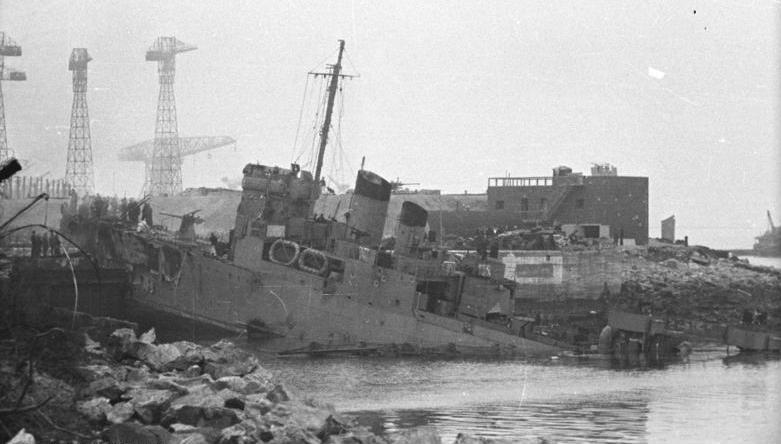
HMS Campbeltown in St Nazaire dock
This was better known as the Raid on St Nazaire, narrated recently by TopGear TV host Jeremy Clarkson (war stories s1) -link. It would be too long to dwelve in detail in the operation, a piece of bravery that succeeded against all odds, with heavy losses, earning documentaries and movies. Instead let’s have a look at the “landing ships” used here: Motor Gun Boat 314 and Motor Torpedo Boat 74 to the jetty, and smaller launches of the 28th Motor Launch flotilla, 7th Motor Launch flotilla, 20th Motor Launch flotilla.
The MLs (Motor Launches) were gathered into the MLs transporting Groups One and Two.
In all, 12 of them from 20th and 28th flotillas, re-armed with two Oerlikon 20 mm guns forward and aft, plus their original twin Lewis guns. Four more were assigned (7th ML flotilla) keeping their torpedoes to engage any German shipping found in the Loire estuary. The 85 tonnes, 34 m Fairmile B MLs had petrol engines and reached 20 knots (37 km/h; 23 mph). They were the proverbial light Jack of all trades of the Royal Navy during WW2 but NOT landing crafts. They were devastated by gunfire, illuminated at relatively short range by the dense German artillery, including FLAK guns of all caliber. Only two survived the onslaught: ML 457 was the one to land its Commandos on the Old Mole and ML 177 managed to reach the gates. Only ML 160, ML 307 and ML 443 came back home.
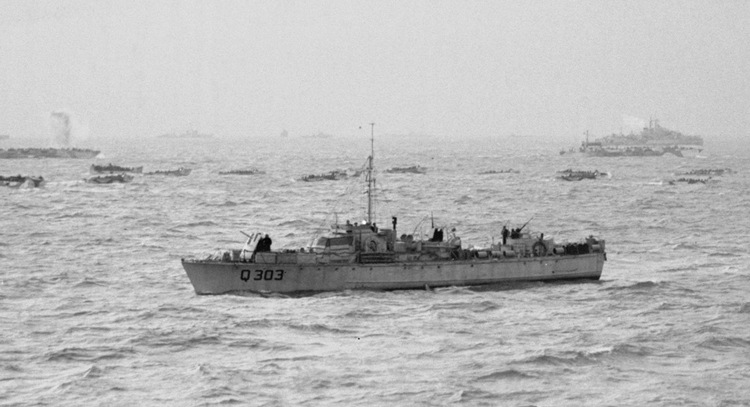
ML303. The bulk of the commandos were to disembark from these Fairmile Type B launches, but only two made it.
More important was the old ex-US DD Campbeltown, used as the major “landing ship” to destroy St Nazaire dock gates with a delayed explosion. Basically she was used as a ram ship, landing Commandos comprising two assault teams, five demolition teams with their protectors and a mortar group.
In addition three Hunt class escort destroyers provided distant cover and nursed for the MLs during the trip. The nature of the raid was essentially improvized with ships that were not designed for a landing. It should be recalled that the St Nazaire Dock was the largest on the coast, from Denmark to Spain, the only place where a ship such as the Tirpitz could be repaired. This was the whole point of the operation that cost the British 169 dead, 215 POW, 13 MLs, 1 MGB, 1 MTB, and 2 planes.
Operation Ironclad 5 May 1942 (Madagascar Invasion)
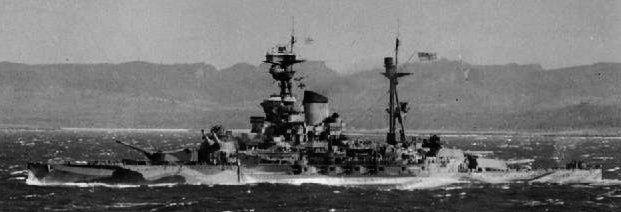
HMS Ramillies during operation Ironclad
The strategic position of the large Island of Madagascar was no lost to the belligerents in WW2. Placed at the western corner of the Indian Ocean, it was a direct threat to British supply lines to and from India and the far east. Part of the French colonial empire it was administered by Vichy France at the time, which allegiance to the axis was assumed. One of the fear was not only it could become a haven, less for long range German or Italian submarines, which access to the area was difficult, but for IJN submarines, as the latter showed they were not afraid to attack targets on the western side of the Indian ocean.
By February-March 1942 the IJN fleet conducted a raid in the Bay of Bengal, bases in Colombo and Trincomalee (Ceylon), forcing British naval forces to relocate in Kenya. It was difficult for Vichy France to resist an invasion in force of the Island given what happened in Indochina, or would be accept to lend bases to the Japanese according to axis plans, so the Royal Navy was ordered to devise a pre-emptive invasion of the Island. For this, an impressive fleet was mustered, comprising 2 aircraft carriers, 1 seaplane carrier, 2 battleships, 6 light cruisers, 22 destroyers, 8 corvettes and other misc. vessels, escorting 5 assault transports. Operation Ironclad started on 5 May. This campaign will be the object of a full-blow post.
In this operation, the force deployed against Diego-Suarez, protected by shore artillery was protected by about 8000 men, mostly indigenous Magalasy. The operation scale left nothing to chance. More important, it was the first large British amphibious assault since the disastrous landings in the Dardanelles. Churchill knew it could be a PR disaster as well as a strategic mishap, notably after the failed operations against Dakar. Prior to the operation, the South African Air Force (SAAF) provided reconnaissance. Force 121 (Major-General Robert Sturges – Royal marines) was to deploy the 29th Independent Infantry Brigade Group, No 5 (Army) Commando, and two brigades of the 5th Infantry Division, supported by 6 infantry and 6 light tanks.
They were to be landed by the 5 large assault transports deploying early British landing crafts for the first time, LCAs.
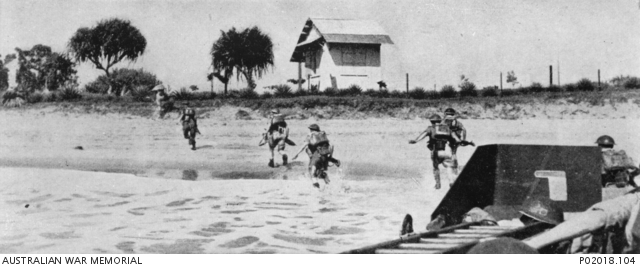
Landing of British troops at Tamatave on LCAs.
The French opposed some naval means: Eight coastal batteries, two armed merchant cruisers, two sloops, five submarines, plus some aviation. The landings were successful, almsot without resistance and the shore batteries and garrisons were seized. There was however some resistance later at Antisarane on 6 May 1942.
Later on 29 May, I-10, I-16, and I-20 arrived on the scene. The midget subs they sent badly damaged HMS Ramillies and sunk the 6,993-ton oil tanker British Loyalty in Diego-Suarez harbour.
After the fall of the harbour, Operation Stream Line Jane was the follow-up, with additional landings to secure other important cities, notably the capital Tananarive in september, but operations went on until November, due to fierce resistance on some points as ordered by the governor Armand Annet, a devout Vichy supporter.
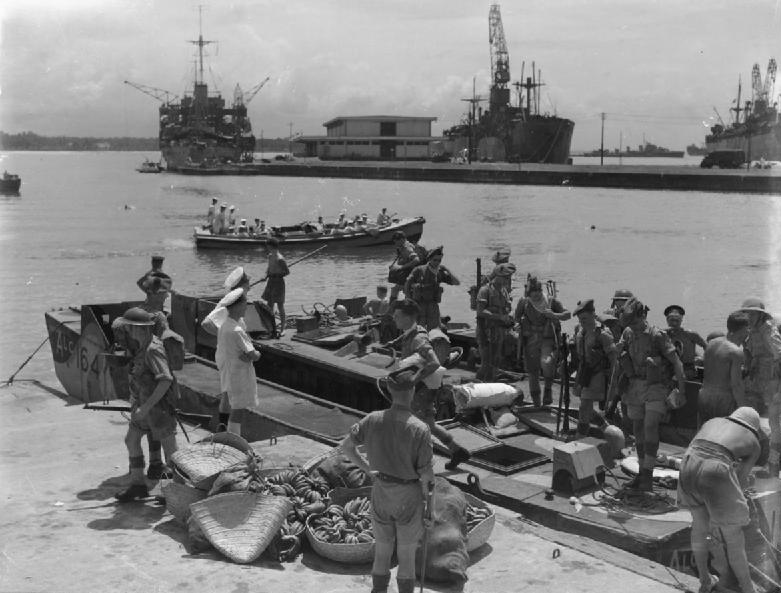
LCAs in Madagascar, late 1942 (AWM).
Operation Jubilee – 18 August 1942: Dieppe Raid
This other famous action that some considered an unmitigated disaster, are considered by others a necessary experiment to validate some concepts of amphibious warfare. In short, this failure was necessary for the success of D-Day.
Strategically, the seizure of Dieppe, on the French coast in Normandy. It controlled no strategic position on the mainland and considerations for the operations were not obvious: The first point was the instance by Stalin the allies opened a second front. It was felt necessary they gave at least the impression to prepare to do so, and made a gesture by a smaller scale operation. Both the US and British felt they were not ready for the large operation required for a proper second front. The second point was less-known: The Fighter Command indeed pressed very strongly for a raid on the coast to provoke the Luftwaffe into a battle that would favour the RAF and deplete it before larger operations would commence, or to not disturbed RAF raids in the area. This was the first step in claiming air superiority that would be effective in June 1944. The operation would consist in 237 ships and landing barges, including eight destroyers. Due to the short distance, most would wait for the best meteorological conditions to make the crossing from the British coast.
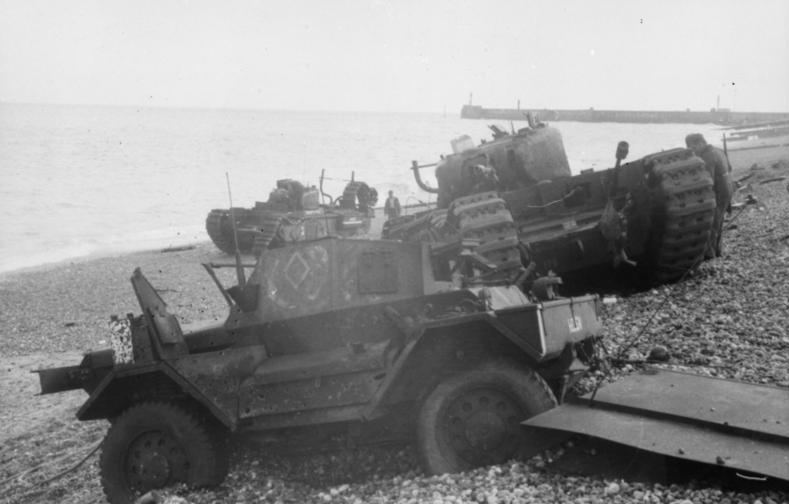
This operation was a mix of British Commandos (5 brigades) and the Canadian 2nd Infantry Division, headed by an enthusiastic J. H. Roberts. These were 10,500 men in all, to be landed on six beaches. The operation was seen as a good real exercise for hard-trained commandos of other nations, including 50 U.S. Army Rangers (attached N°4 Commando) and 15 French ones (N°10). Opposing was the German 302nd Static Division, with a solid defence, small ships, limited aviation support but no tanks. The Canadians however (and that was the most interesting part of the operation) were to land the supporting 14th Army Tank Regiment, or The Calgary Regiment (Tank).
58 of the new Churchill infantry tanks, were to be carried and landed by the new landing craft tank (LCT). Some of the tanks were given the standard 2-pdr, other mortars, and three flamethrowers: Modified by Major J.M. Oke they were called “Boar”, “Beetle” and “Bull” and landed on the first wave.
The operation combined many “firsts” and was a large scale amphibious operation, larger than the small commandos raids that had be launched on the coast via submarines until that time, or afterwards. The use of Tanks landing crafts notably, and on paper, the massive armoured support was to win the day. The allied command was confident. The air battle, as expected, was fierce: The RAF committed no less than 74 squadrons and indeed, depleted the Luftwaffe, but at very high cost, claiming 23 Fw 190 and 25 Dornier Do 217 for the loss of 64 Spitfire, 20 Hurricane, 6 Douglas Boston and 10 N.A. Mustang (RAF). Most were downed by the merciless FLAK in the area. On the naval side, the allies lost no less than 1 destroyer and 33 landing craft in the action, while the Kriegsmarine lost the sub-chaser trawler UJ 1404.
On the ground, they lost far more: 907 killed, 586 wounded, and 1,946 captured and all tanks and armored vehicles. The failure was in part due to a critical oversight: The nature of the beach, made of pebbles, which jammed the tracks and left the tanks stranded on the open, easy targets for German mortars and artillery. The German resistance was fiercer than expected and there was no preliminary bombing for fear of angering the French population, another consideration two months before Operation Torch.
The real value operations as most historians agreed, was to create a notebook for the allied command of what was necessary to succeed:
> Preliminary artillery support/aerial bombardment
> Sustained element of surprise/deception (the Germans were well prepared, possibly an intelligence leak)
> Proper intelligence concerning enemy fortifications
> Avoidance of a direct frontal attack
> Proper re-embarkation craft (no landing craft could disengage after beaching that day)
Operation Sledgehammer (1942) Cancelled D-Day
See also Operation Gymnast.
The famous opening of the second front, strongly advocated by Stalin to relieve the pressure by his western allies, had to wait until June 1944. It was postponed many time. All concurred however, the latter were not ready for such operation in mid-1942. The huge armada necessary was not there yet, the Atlantic was yet not secure (in fact there were the most profitable time for submarine warfare), and the US Forces were still not yet fully organized, equipped, trained, led, and more importantly, without experience of real combat.
The British and commonwealth forces were not enough in addition to lead the assault alone to have some chances of success, and were already stretched out in the far east and Mediterranean. Until the situation was clarified, as argued by Churchill, in the “soft underbelly” of the axis, no great operation in the north had chances of succeeding.
However later in 1942, the allied commanded studied a large cross-Channel invasion of Europe with existing means, as a contingency alternative to the larger Operation Roundup scheduled for 1943. The goal was more limited in scope: Seizing Brest or Cherbourg and places in the Cotentin Peninsula in order to larger fortify the position for more reinforcements and start a breathrough in the spring of 1943. The Cotentin peninsula indeed was a stretch of land easy to defend with a single line, provided there was enough men, material and supplies to defend the area for long months.
It was an incredibly risky plan on the British point of view, but pressed forward by the US and Soviets on the insistence of Vyacheslav Molotov. The British command through it was premature and in the end the plan was postponed and cancelled. Instead, Churchill won a reluctant Eisenhower and high command to an operation in North Africa, operation Torch. Sledgehammer was considered “feasible”, although lacking air superiority and amphibious warfare equipment, notably the proper ships needed for the assault. Risky, as there was just enough ships to carry six divisions whereas the Germans in France and Western Europe had 25 to 30 divisions. Both Brest and Cherbourg had been severely fortified, waters around heavily mined, and fast armoured divisions kept at the rear in reserve ready to pounce on any invasion.
Operation Agreement (5 Sept. 1942)
The siege of Tobruk undermined British presence in north Africa and threatened the Suez Canal. The high command planned a relief attack which was to draw out besieging forces, and capture the Jalo oasis, a strategic point for a retreat. It was ordered to take place on the 5 of September and mobilized a naval force of 1 cruiser, 6 destroyers, 16 MTBs, 3 Motor Launches, 30 landing craft and one submarine. The latter, HMS Taku, was to set up beacons on the shore to guide the landing force but failed to do so due to heavy weather.
The landing force comprised, 400 Royal Marines, 180 Argyll and Sutherland Highlanders (Captain Norman MacFie), the 14 Platoon, Z Company, I Battalion of the Royal Northumberland Fusiliers (Lieutenant Ernest Raymond) and army engineers of Force B (Lt. Col. John Edward Haselden). This was coordinated with Rhodesians and New Zealand Long Range Desert Group (LRDG) with 50 men, 12 light trucks and five jeeps, tasked to assault Barce airfield. This was a success but when retreating near Zaptié they were intercepted and destroyed by an Italian column. Meanwhile, Lieutenant Colonel David Stirling at the head of the Special Air Service tried but failed to raid Benghazi.
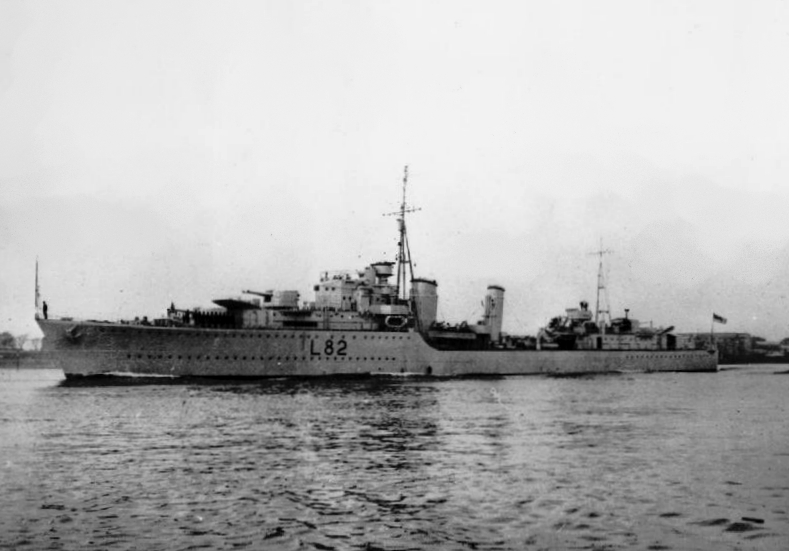
HMS Sikh. Both Sikh and Zulu, precious, costly British destroyers of the Tribal class were lost during or after the operation, which also cost one anti-aircraft cruiser, HMS Coventry, four MTBs,
two MLs and many landing craft.
Force A was landed by destroyers Sikh and Zulu, and the first was sunk by coastal gunfire and later HMS Zulu was sunk in turn. They intended to land on the peninsula north of Tobruk, but failed. Force B initially captured the main Italian 152 mm coastal battery, but it was retaken by a vigorous assault of the elite Italian marines of San Marco Battalion, most shore batteries and positions remained unharmed and active. Force C (small coastal units) penetrated an inlet east of Tobruk harbour, but were spotted and gunned at short range by the Italo-German forces.
Losses were appealing as only MTB 261 and MTB 314, made it into Marsa Umm el Sciausc cove. ML 352, MTB 308, MTB 310 and MTB 312 were destroyed by aviation. A motley fleet comprising the torpedo boats Castore, Montanari, armed tug Vega, German harbour minesweepers and motor barges captured the rest. The whole operation was an embarrassment for the British command and Tobruk will eventually fell.
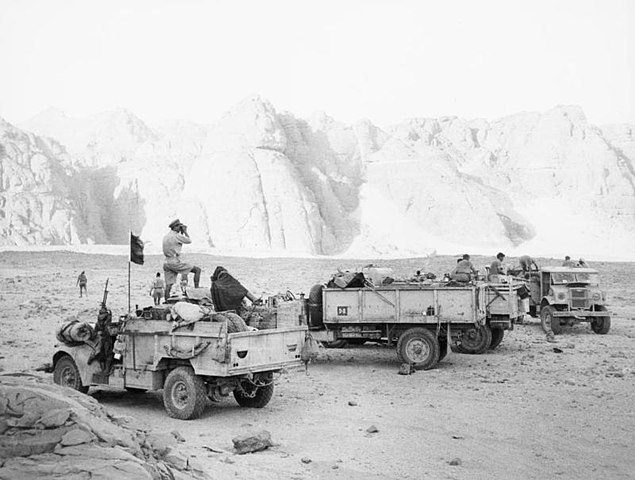
The LRDG component of the attack, Force B, succeeded in destroying an airfield but was later intercepted and destroyed in turn. The operation had little lessons to offer but to better prepare a large scale operation to have chances of success in occupied North Africa.
Operation Roundup (1942-43) Cancelled D-Day
This was another grand plan to invade Northern France in the spring of 1943. It was overseen by Brigadier General Dwight D. Eisenhower as THE major landing operation, and is generally considered the ancestor of Operation Overlord. It was not without reluctance of the British command, expecting heavy opposition by forces already mustered in the Pas de Calais, the most obvious route for an invasion. The British evoked a, bloody grinding battle of attrition with painful losses such as those encountered during the Battle of the Somme and Paeschendale.
However the massive assault was to land 48 divisions but was soon to hit a logistic wall: Acute shortages of merchant shipping, landing craft, and other resources. The massive naval construction plans to replace losses of the Battle of the Atlantic were just getting started. The landing area was situated between Boulogne and Le Havre. For the US staff, which as enthusiastic about the plan, the lack of transport ships, which meant only a small fraction of the intended divisions was landed on D-Day was compensated by the short distance, meaning more round trips would be necessary to solidify the beach head.
However at the Second Claridge Conference in late July 1942 the Brituish views prevailed and it was decided to carry out Operation Torch, with the ships and material means in men and resources diverted for the new operation. In the end preparations for Roundup were given lower due to uncertainties in the allied Allied strategy and in November 1942 Eisenhower recoignised himself no operation of this scale would be undertaken before 1944.
Operation Torch 8 Nov. 1942 (Invasion of FNA)
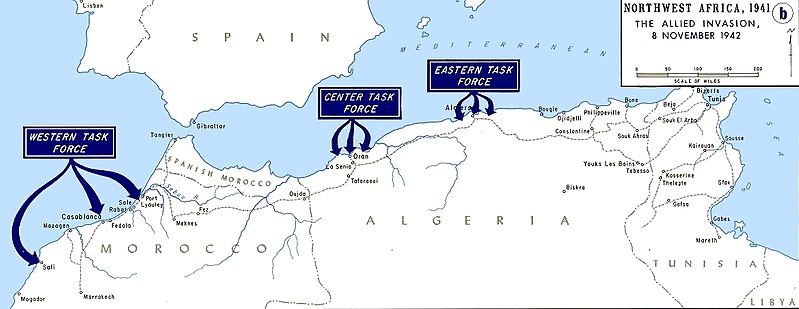
The largest allied landing operation of the war so far. Apart Dunkirk in scope, which was the exact opposite, an improvized evacuation by sea, using a collection of ships of various origins, Operation Torch was a major endeavour pushed forward by Churchill. Both the US Command (Led by C-in-C G. Marshall, which limited for a pacific first strategy opposed by Roosevelt), and Stalin’s high command insisted in opening a second front directly in Western Europe. Adamant in his approach of the “slow underbelly”, the British command eventually won the support of Eisenhower which recognised that a landing in Vichy-France had better chances of success for the “green” US troops, than directly in Italo-German occupied Libya or Tunisia, as shown by Operation Agreement earlier, or Dieppe.
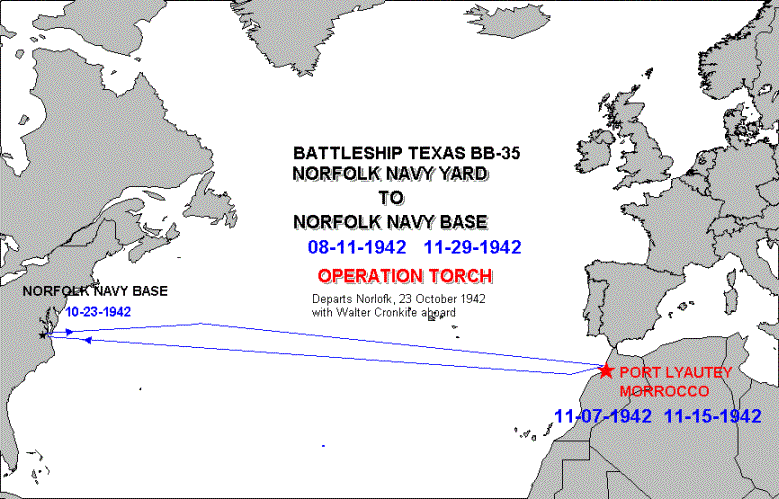
Operation Torch, route taken by the Western Force – credits: battleshiptextas.info
The hope was this invasion, not only would take axis forces in North Africa in a pincer (which succeeded later), but also made Vichy France swap sides if possible (which partially worked). It also contributed to give US Forces precious operational lessons afterwards, at Kasserine notably. The fall of North Africa would also bring a considerable supply of troops to the free French, which took a growing part in the operations in the Mediterranean, specially in Italy and from August 1944, in mainland France, where they made 50% of the forces deployed during operation Anvil Dragoon.
The amphibious operation scale was unprecedented indeed: The objective was to combine three allied forces coming from mainland British Islands down to three landing areas separated by thousands of miles on the North African Force: The Western US sector at Casablanca and Port Lyautey notably in Morroco, the center task force at Oran, and eastern task force at Algiers.
Western US Sector (M. G. George S. Patton, Rear Admiral Henry Kent Hewitt): U.S. 2nd Armored Division and the U.S. 3rd and 9th Infantry Divisions
Center US Sector (M. G. Lloyd Fredendall, Commodore Thomas Troubridge): U.S. 2nd Battalion, 509th Parachute Infantry Regiment, the U.S. 1st Infantry Division, and the U.S. 1st Armored Division
Eastern Task Force (Lieutenant-General Kenneth Anderson, Vice-Admiral Sir Harold Burrough): Single brigade, British 78th ID, U.S. 34th ID, Two British commando units and various RAF units;
Large stars and strips flags and stars in roundels, leaflets and later megaphone calls plus a secret operation intended to avoid a fight between the numerous French troops under orders from Vichy to defend the coast at all costs, and there was initial heavy fighting in some areas, with losses on both sides. French admiral Darlan’s swap after negotiations ended the slaughter.
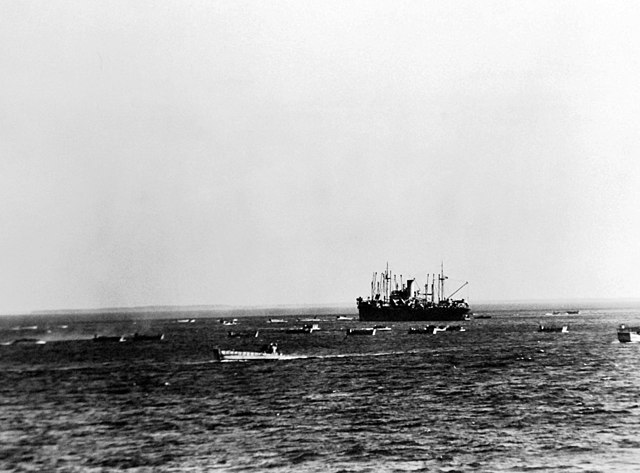
US Force landing crafts in November 1942
We will concentrate here on the British side of operation, on the Eastern sector. The British participation was kept minimal here, due to the animosity born from the attack on Mers el Kebir in November 1940, seen as treacherous by the French and which led to a rupture of diplomatical relation between vichy Fraance and London, but it was not the case for US Forces. For the first time a large array of brand new landing crafts and assault ships were used. In fact most amphibious ships and crafts mustered in this sector were mobilized. The total represented an unprecedented armada of 500 transports, mostly assault ships and large LCTs, medium LCIs, protected by some 350 allied warships of all sizes, including many battleships and several aircraft carriers.
Initial landings were made on beaches, with the hope that the port of Oran, Algiers, Casablanca would quickly fell and be used in a second phase for reinforcements brought by regular freighters and liners. However in Oran the situation was quite different: Operation Reservist failed, as the two Banff-class sloops carrying British troops were taken by a deadly cross fire by the Vichy French artillery, coastal batteries and ships present here, and were sunk. Despite the US markings it was soon known British troops were there and stubborn resistance was only taken down by a massive artillery barrage from the British battleships, bringing Oran’s surrender on 9 November 1942.
The British already had some experience in landing operations, which otherwise proceeded relatively smoothly. On the US side there was a different matter. Many inexperienced soldiers drawn after falling from their nets on the flanks of the assault ships before gaining the LCIs. There was some confusion also in the landing zones. But overall the operation was a success, with fighting ending on 16 November.
The allies deployed 39,000 near Algiers, the British and commonwealth (Indians, Canadians, Australians, even a small contingent of Free Dutch and free French) took 574 dead and many casualties. Ships losses amounted to four destroyers, six troopships, one minesweeper and one auxiliary anti-aircraft ship plus an aircraft carrier, HMS Avenger on all three fronts. The whole operation showed that a long-range convoy fleet can land troops, that coordination was to be improved, training for the troops to transit from the assault mothership to the lighter landing crafts was necessary, and use doctrine for some crafts to stay around waiting for the others in order to present a mass landing instead of penny-packets of troops that can easily be moaned down. All this was to be perfected in the Pacific and in June 1944, thee tactics were much more rounded.
However two limitations soon appeared: The French were not the Germans and if in isolated case they fought stubbornly (a few snipers for example pinned down the 1st US I.D.), neither the level or preparation or will to fight for Vichy were there. In addition the FNA coast was not the Atlantic wall. Landings were met with little to no opposition and casualties overall were pretty light. Fortunately more were to come, decided at the Casablanca Conference in January 1943, in order to prepare also D-Day.
Operation Husky 9 July 1943
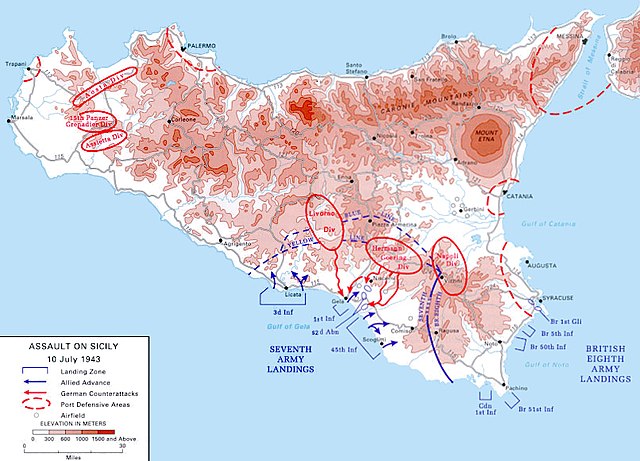
Next step in the “soft underbelly” of the axis, Husky was planned as the Afrika Korps and the remnants of the Italo-German forces, trapped in Tunis, escaped to Sicily. The island, at the crossroads, hinge between the western and eastern Mediterranean was already strategic in the antiquity. The belligerent needed to hold it, helped by the rough terrain. It was seen as an outpost of Italy itself. There, Italian and German troops fought furiously (particularly the latter) under command of General Adolfo Guzzoni.
The operation was preceded by a successful deception, operation Mincemeat, probably the most famous corpse of WW2. It was also preceded by Operation Corkscrew: The invasion of the Italian island of Pantelleria on 10 June 1943 and just before the landing at night, Operation Narcissus, a Commando raid on a lighthouse near the main landing area on 10 July.
The allies would land 160,000 personnel and 600 tanks assisted in next waves by 14,000 vehicles and 1,800 guns for the breakthrough. The campaign soon turn into a race towards Messina between Montgomery and Patton. Total losses were much higher, as expected, compared to Operation Torch: The United Kingdom and Canada alone had 2,721 killed, 7,939 wounded and 2,183 missing. This was land battle and few ships were lost or even damaged. The Regia Marina did not had the strength to do much harm to the armada at this point. The axis had the elite fallschirmjager batallion and Hermann Göring Panzerdivision and the Luftwaffe, (1400 planes of the axis combined), 240 tanks (Italian) plus still 131,359 –252,000 Italian troops and personnel.
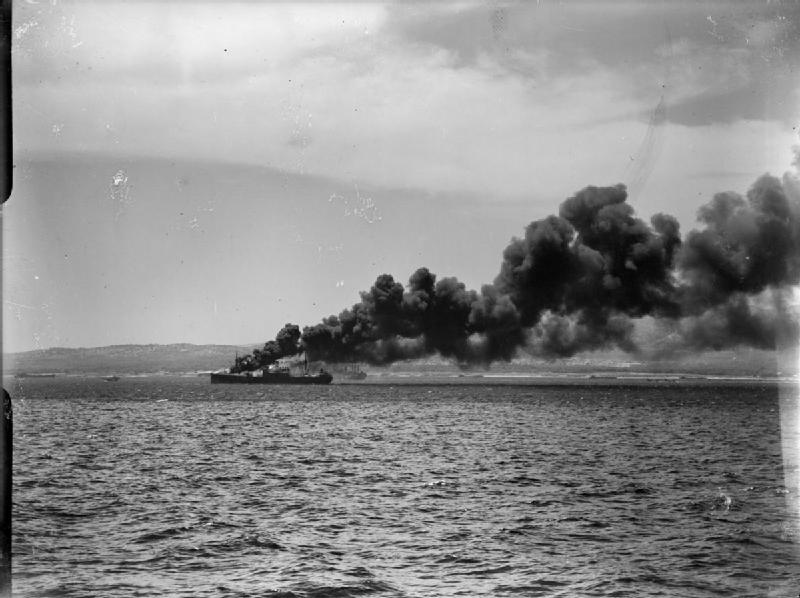
An ammunition ship of the Royal navy hit by aviation, burning four miles south of Syracuse.
For the first time, the operation also called for airborne landings. The idea was to seize key point on the map, such as bridges and crossroads. They were few practical roads in Sicily so defence was very previsible. The landings themselves were a surprise thanks to the deception and largely unopposed. Indeed, the bulk of axis forces were massed in the west, near Trapani and Marsala. Despite of this, axis aviation soon targeted the armada for several days, and in all the U.S. Navy lost 546 killed/missing, 484 wounded and in the Royal Navy 314 killed or missing. The British and Canadians (8th Army) landed on the eastern sector, south of Syracuse. These were the 1st, 3rd and 50th Brigades, and the Canadian 1st ID on the southern coast near the British 51th Infantry Brigade at Licata.
Operation Baytown 3 September 1943
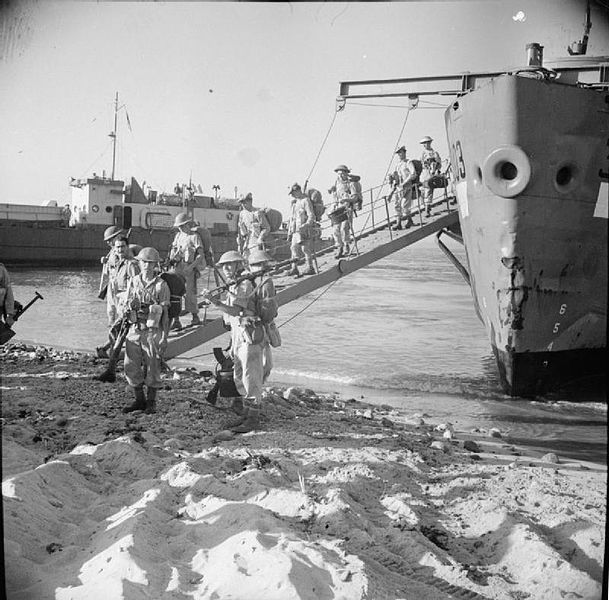
Operation baytown comprised only British and Commonwealth (Canadian) troops, and targeted the Italian mainland, at Reggio Calabria, in the tip of the boot. The decomposition of the Italian Army however provoked, as expected by the allies, a power shift, as the King and his staff disavowed and emprisoned Mussolini. Landings played an important role during the whole Italian campaign, due to the long coastline and nature of the terrain, which favoured the defensers. The most famous was Operation Shingle, on 22 January 1944, to unlock the situation (battle of Anzio) by attacking the German’s back; The same principle was applied by MacArthur in Inchon, Korea in 1950.
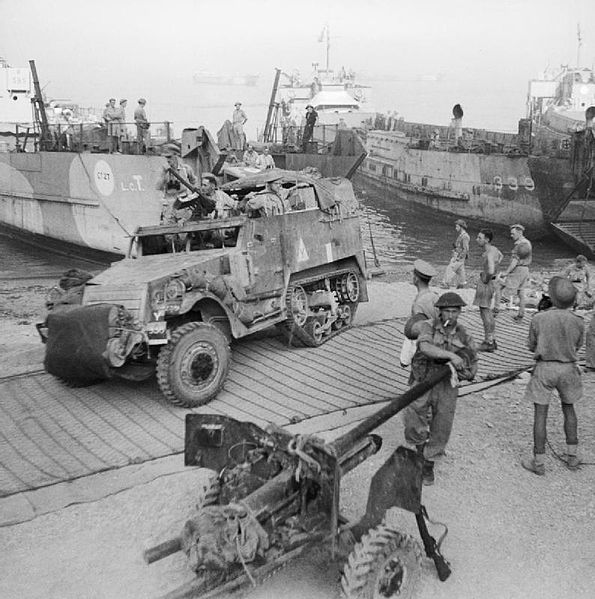
Operation Slapstick/Avalanche 9 September 1943
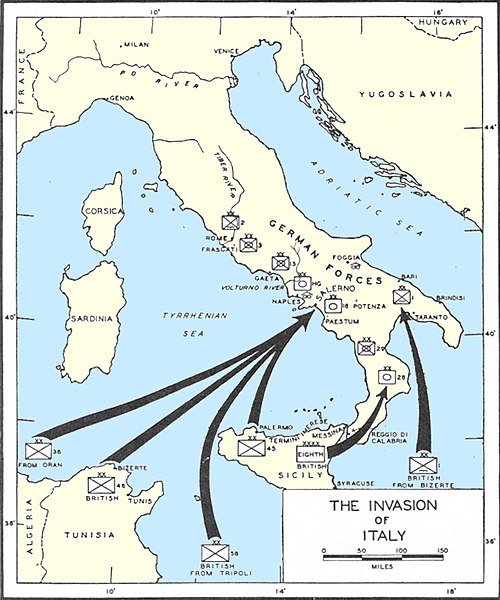
The Italian front needed soon a grand operation on the Italian mainland, north of the ongoing invasion of Italy to create a pincer. “Avalanche” was a codename for the combined Allied landings near Salerno, a strategic port. It was planned in detail (‘Top Hat’) during the campaign of Sicily to start asap, preceded by a deception named Operation Boardman. The landings commenced on 9 September 1943. Remarkably, after their defeat in Sicily, the Italians withdrew from the war and the allies would face from now on only German troops.
This was mainly an US-led operation, with the US Fifth Army under General Mark W. Clark but preceded by the 1st British Airborne landed for a diversion by sea near Taranto.
Later the main northern landing by sea (South of Salerno) included the Northern Landing Force (carried by TF58 under British command, Commodore G.N. Oliver), which landed and supported the British X Corps (Lt. Gen. R. L. McCreery). Tactical surprise was achieved and the landings were unopposed. However past the Beach head, Kesselring’s forces mobilized and lines fortified. It took until mid-January 1944 of heavy fighting around the Volturno to take Barbara, Bernhardt, before finally reaching the Gustav Line… No particular point was of note for the amphibious operation in this deployment of 190,000 troops, including Canadians. The Royal Navy suffered 83 killed and 42 wonded, far less than the US Navy.
Operation Shingle 22 January 1944
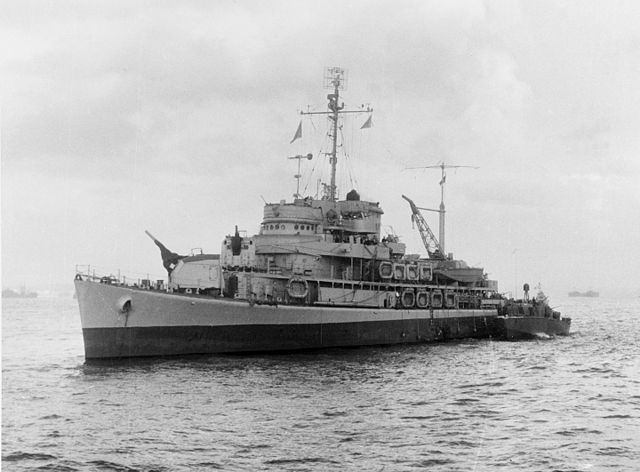
USS Biscayne (AVP-11), amphibious command ship of Rear Admiral Lowry’s at Anzio
The diversionary landing operation is also known as the Battle of Anzio was setup to break the stalemate of the winter line, outflank and possibly surround German Forces at capture Rome.
This was an ambitious undertaking to say the least, where British and Canadian troops played a crucial role. In all 36,000 men and 2,300 vehicles were landed. Most of the latter were trucks, but tanks, M4 Sherman and M3 Stuart made the bulk of the first wave. The British 1st Infantry Division (Major General W.R.C. Penney) US Ranger group, “X-Ray” Force were part of the assault.
The mail problem for this operation was the lack of landing ships. The US commanders at that time prevented available LSTs to be sent in the Mediterranean, this would delay the 1944 invasion, even ships gathered for the future southern France landings. President Roosevelt eventually unlocked the situation and granted permission for the landing ships and craft to be available for any operations until February 5, 1944.
The minimum of LSTs landed a single division initially but on Churchill’s personal insistence, more were mobilized to carry two more divisions. Allied intelligence and U.S. 5th Army intelligence conflicted over the strength of the Germans there, the latter gravely underestimated it. In fact the 10th Army were not worn out since September nor in understrength. In total, the Germans opposed 6 divisions, 20,000 German infantry and 4600 Italians of the Italian Social Republic.
Surprise was achieved and a beach-head was soon taken, but the proximity of German forces meant the landing forces positions were later contested by Kesserling’s vigorous counter-attacks. The Luftwaffe was the first to attack. The problem was the cautious approach of John P. Lucas which waited for reinforcements for his small bridgehead, loosing momentum and a precious time; When he estimated his forces were ready to march, the Germans waited for them, in well-prepared position along the main and only ways.
Operation Neptune/Overlord – 6 June 1944
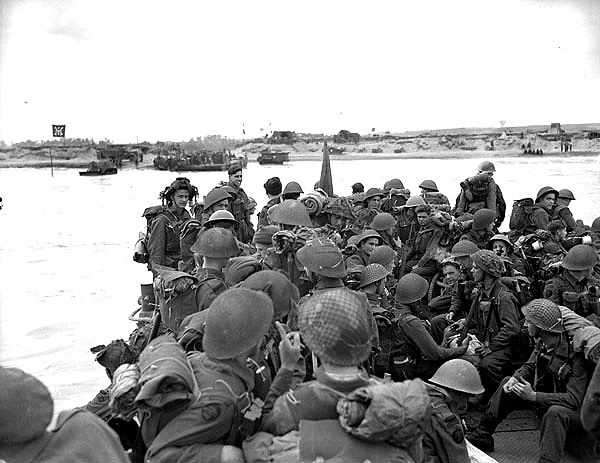
Canadians at Juno Beach.
Everything has been written on D-Day since the events unfolded, 76 years from now, the duration of an average human life. So we will not peak into this, reserved for a dedicated post later; but concentrate on the British side and amphibious means deployed here. British forces at D-Day represented the second largest forces after the US, and landed at Gold Beach (XXXth corps, 50th Infantry Division), Sword beach (Ist corps, 3rd Infantry Division and preliminary airdrops of the 6th Airborne Division) while the Canadians participated in Juno landings (3rd Canadian Infantry Division).
In addition, Polis, Czech, Free French, Australian, Norwegian and Kiwi forces also participated in what D. Eisenhower called then the “grand crusade”. Indeed, postponed several times, the operation was launched whereas the Soviets had already mostly won on the eastern front. After Stalingrad and Kursk, the German front crumbled everywhere and Operation Bagration was launched to create a gigantic pincer movement across Europe.
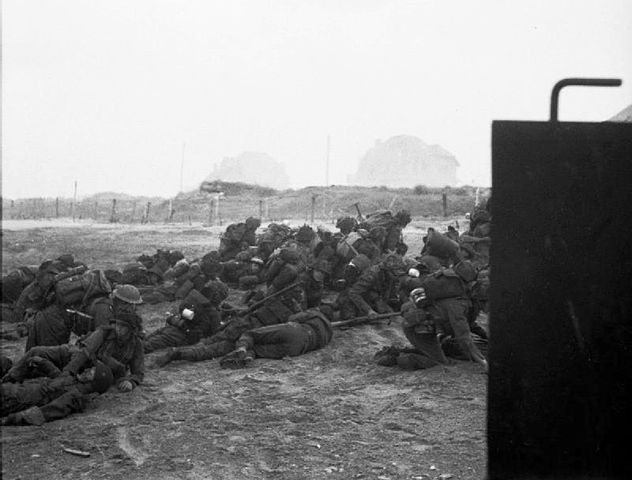
British Infantry at Gold Beach.
Apart at pointe du Hoc where US Rangers used British LCAs, US Forces relied on USN amphibious ships and crafts, due to their very large production to the exception of a few British support vessels (see later) and many of the British used lend-lease US-built vessels, partly inspired from British designs dating back from 1938.
At Gold Beach, landings started at 07:25 due tide differences, but in high winds ad waves. Many low-freeboard crafts such as LCAs were submerged, some even capsized as where many duplex-drive amphibious Sherman DDs. Most never made it. Soon most amphibious DD were released very close to shore or directly on the beach. The cruisers Ajax and Argonaut closed in dangerously and silenced batteries of four positions.
Le Hamel strongpoint was silenced by an AVRE tank and La Rivière by another tank at 07:30. Heavily fortified houses along the shore fell by the infantry while No. 47 Royal Marine Commando took Port-en-Bessin. On the western flank, the 1st Battalion Hampshire Regiment captured Arromanches and later linked up with Canadian forces at Juno. This was a contested landing but losses were nothing compared to Omaha, with 1,000 kiA.
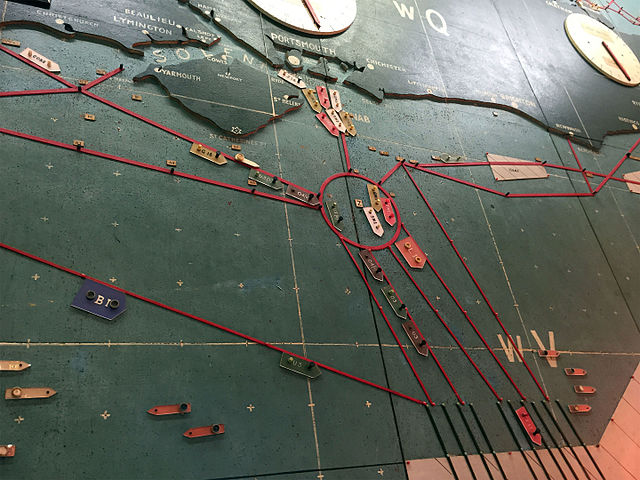
D-Day map at Southwick House.
By that stage, troops and tanks had been landed by most of the classes of ships described on the second part of this post, such was the immensity of the amphibious armada:
508 ships total, but 352 were British and 154 US. Most famous British vessel was HMS Bulolo, which served as the Landing Ship Headquarters (LSH) for Gold Beach. HMS Dacres frigate was converted as a headquarters ship. HMS Hilary, Kingsmill, Largs, and Lawford, also served as HQ ships.
It was covered by no less than 4 British battleships and 19 cruisers: HMS Nelson, Ramillies, Rodney and Warspite, and for cruisers HMS Frobisher, Hawkins, Argonaut, Ajax, Arethusa, Belfast (Flagship of Rear Admiral Frederick Dalrymple-Hamilton), Bellona, Black Prince, Capetown, Ceres (Flagship of U.S. Service Force), Danae, Diadem, Emerald, Enterprise, Glasgow, Mauritius (Flagship of Rear Admiral Patterson), Orion, Scylla (Admiral Vian’s flagship), and Sirius, plus 85 British Destroyers and escort vessels. The Royal Navy made 2/3 of the armada during this operation.
The British also contributed to the invention, development and production of Mulberries, the famous modular artificial ports necessary before large harbours on the coast could be secured (most fell at the end of 1944 ot even the end of 1945 such as Dunkirk). The two artificial ports (Arromanches and Gooseberry at Sword and Gold beach) would supply allied forces during the whole Normandy campaign and the push through France and to the Rhine. After the conquest of the south of France indeed in August-September, allied forces had a least one large Mediterranean port, Marseille, to supply the front through the Rhodanian valley (Rhone river).
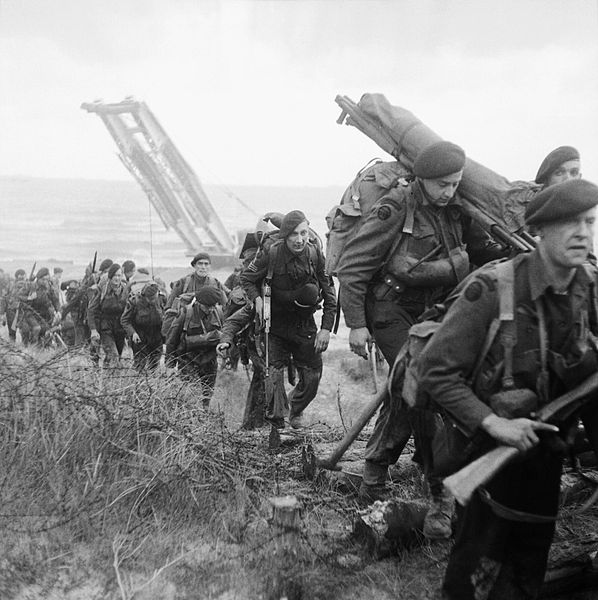
Royal Marine Commandos 3rd Division at Sword Beach 6 June 1944
Operation Dragoon 15 August 1944 (S France Invasion)
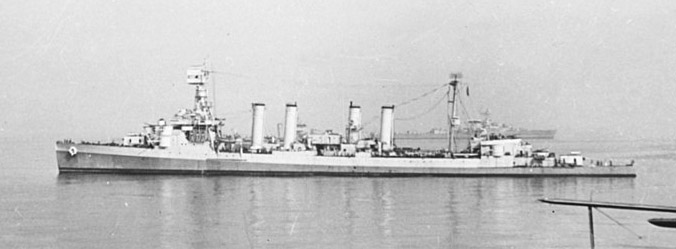
USS Omaha off Cavalaire, southern France, August 1944
Well before the allies started to bog down in the hedgerows of Normandy (until operation Cobra), another landing, often eclipsed by D-Day, was mounted in the south of France: This was operation Anvil Dragoon. The anvil was the push northwards in coordination to allied forces in the west, trying to take German forces in a pincer, possibly even trapped them. Apart the Falaise pocket, most of retreating German forces escaped the allied onslaught.
Operation Dragoon was mounted a bit with some British resistance as this would divert forces from Italy where other landings were planned. The Allied invasion of Provence (Southern France) on 15 August 1944 would not be dealt there in depth as it was a joint US-Free French landing, with limited British and Canadian forces. Like in Normandy, the first wave saw 150,000 men on the shore that day.
This was not a promenade: The allies took 25,574 casualties during the whole operation, but the assigned objectives fell well before planned schedule, well helped by the local resistance. The terrain also, while rugged favoured armoured vehicles with open terrain and poor vegetation, and the bright sky authorized a constant air support from from Italy, Sardinia, and Corsica. In the initial phase, 1,300 Allied bombers prepared the terrain by hammering key objectives, and paradroppings and commando raids prepared the terrain. The relatively steep beach gradients, small tidal range made impossible the use of underwater obstacles, but mines instead, dealt for by Rocket firing LCIs. After the coast was secured the following day, allied forces advanced quickly and the Germans fought a rearguard action but took heavy losses in the process, with 159,000 casualties. Landings were covered by more than a hundred ships, mostly USN, including the British battleship Ramillies, 20 cruisers and 9 escort carriers (Task Force 88).
These landings saw the first amphibious ship sank by a missile, USS LST-282 by a rocket-boosted Henschel Hs 293 guided gliding bomb (Do 217 from KG 100).
Despite this success however, as the German forces crumbled after the battle of Montelimar, the allies failed to catch and trap Army Group G, which retreated in good order over 500 miles to the Vosges Mountains and the German border. Many subsequent fights in the Vosges and later in Alsace-Lorraine included survivors of this escape. With the capture of Marseilles nevertheless in October, 524,894 tons of supplies were unloaded and transited north, about 1/3 of allied supplies in France. Nevertheless Montgomery considered it a waste of resources and men that could have been injected in the Western front instead or to pierce the Gothic line in Italy, and penetrate in Bavaria in 1945.
Operation Switchback – 9 October 1944
Also called the Battle of the Scheldt, this operation was one of the last allied amphibious crossings on the western front. It was not a maritime landing but a massive river crossing to the Netherlands, using many British (2nd Army) and Canadian Forces, the latter in particular engaged the whole 1st division, for a total of 135,000 men. The main objective was the capture of the port of Antwerp. In this operation, landing ships and crafts were replaced by amphibious tracked and wheeled vehicles: US-built Amtracks such as the Buffalo, various LVT marks were used, as well as DUCKW trucks and the infamous SEEP (or “aquatic jeep”). With this operation “Monty” regained a bit of the luster lost at Arhnem for its “bridge too far” (Operation Market Garden). This was completed later from 24 October 1944 by the third phase of the battle of the Scheldt, Operation Vitality. The objective was to clear the peninsula of South-Beveland of German forces.
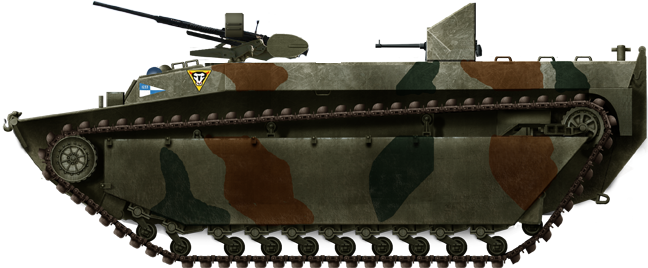
Buffalo IV of the 79th Armoured Division, Rhineland, March 1945. Notice the 20 mm (0.79 in) Polsten autocannon (author’s illustration).
Operation Infatuate – 1 November 1944
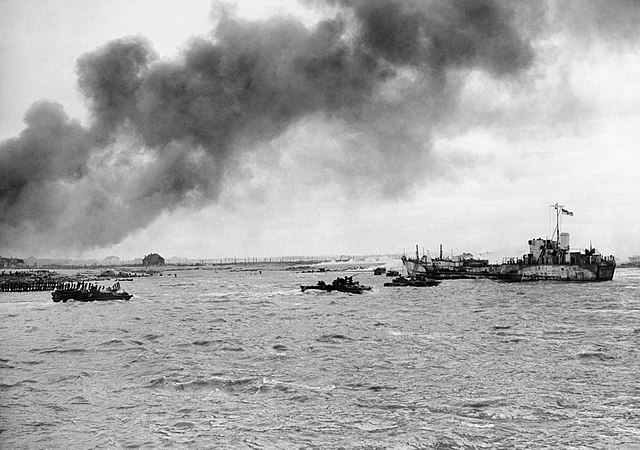
Royal Marine Commandos at Walcheren. They used DUKW’s, LVT, LCT’s and Buffalos on 1 November 1944, some vehicles launched while in submerged LSTs, used as had oc LSDs.
Last great operation linked to the aftermath of the Battle of the Scheldt, Infatuate objective was to open the port of Antwerp to shipping. For this, the allied forces comprised the 4th Special Service Brigade and 52nd (Lowland) Division, reinforced by the mass of the 2nd Canadian Infantry Division. The 79th Armoured Division provided specialist amphibious vehicles for the assault, supported by naval gunfire, and combined Landing Craft Assault (Gun) types and “Land Mattress” multiple-rocket launch systems. Meanwhile No. 2 Dutch Commando took Brugge in Belgium. Norwegian and French commandos also participated in the operation. It was a success and Antwerp was taken while soon, the rest of the Netherlands fell. The cost was a large displacement of population from the area, due to the Inundation of Walcheren, the allies took 1473 casualties. They were opposed to 5,000 troops of the German 15th Army and captured 2/3 of them.
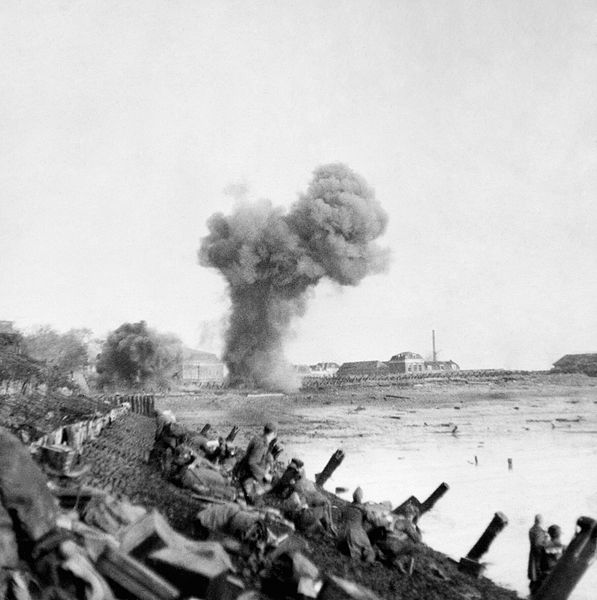
The assault on Walcheren, British troops advancing along the dikes.
Far East Operation of October 1944-April 1945
The “Victor” Operations followed closely ‘King II’ in late October 1944 and Operation Musketeer II in January 1945, the landings in the Philippines by the USN. As Germany and the Western Campaign approached its conclusion, allied amphibious forces were needed elsewhere, in the Pacific. There, Commonwealth forces, carried by the whole Royal Navy dragged from the Atlantic and Mediterranean, were sent through the Suez canal along thousands of landing ships to regain lost territories in 1941-42. The British sector involved all the terrain lost from the eastern Indian frontier to Indochina. This included jungle terrain of Burma and Malaya, but also Indonesia. Operations called “victor” were part of “Montclair III” plan, launched from 25 February 1945 in southern Philippines; This Philippines campaign only comprised US Troops, with some Australian participation with ships and planes and even included Mexican air support.
Operation Dracula – April-May 1945
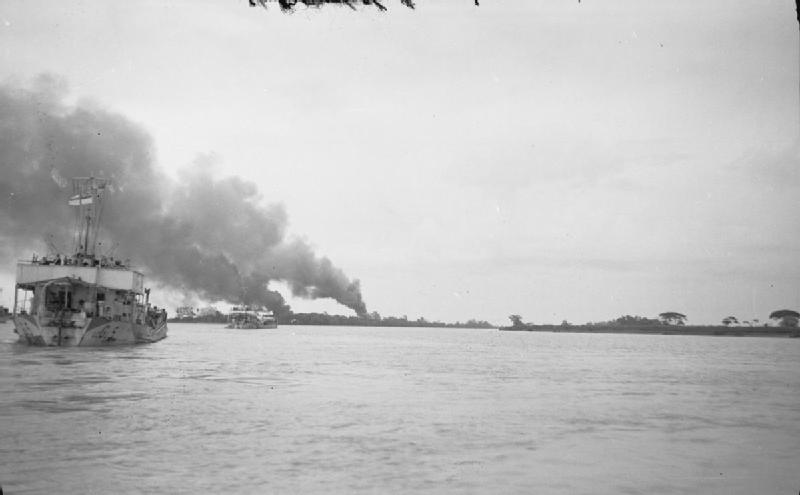
British LCTs during Operation Dracula.
The most striking operation of the British and commonwealth as they returned in force was the campaign of Burma. It consisted in an amphibious attack on Rangoon by a combination of British, American and Indian forces. The whole was called the Burma Campaign, and lasted from April to May. The operation was planned in mid-1944 already but the amphibious forces needed were not there. It would take the fall of Germany and tranfer eastwards of all forces available to start operations again.
The spearhead of the operation was the British Fourteenth Army, which committed one infantry division and an airborne battalion to the operation. Support naval forces comprised a motley collection of British, RIN, Free French and Dutch vessels. The main objective was Rangoon, capital of Burma and major port in the region. It was necessary for further operations in the region, either pushing south to free Indochina and North to help the Chinese. It was preceded by operations in late 1944 such as the conquest of the Burmese coastal province of Arakan by the Indian XV Corps (Lt. Gn. Sir Philip Christison) and the prize on 31 December 1944 was the capture of Akyab Island airfield. It was followed by an invasion of Myebon peninsula in January 1945, and then the capture of Cheduba Island, and Ramree Island, on which airfields were constructed to help in future operations, notably massive paradroppings.
The Fourteenth Army (Lt. Gen. William Slim) after landing started the major Battle of Central Burma, followed by the Battle for Rangoon. Oddly, Indian forces met deserters of the Indian National Army, former POWs pressed into service in an auxiliary unit of the IJA. At Rangoon, the combined forces met little resistance by Lieutenant General Hyotaro Kimura which decided to led the remnants of the original troops in the area further east. The city was evacuated. The campaign closed in April by the Battle of Elephant Point and in May with the Battle for Pegu.
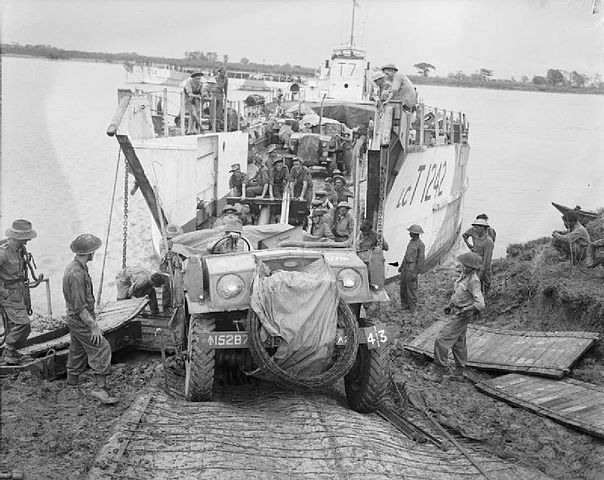
LCTs at Elephant Point, May 2, 1945.
Operation Oboe: Borneo campaign (1945)
Borneo was located south of the Philippines and it sounded logical to reduced the area to secure the southern passage. Operation Oboe was part of the much larger Operation Montclair for the reconquest of the southern path to Japan, from Indonesia to the Philippines, and concerned the Netherlands Indies, led by Australian forces in order to seize of Borneo, Java and adjacent islands. Contrary to usual one-day massive landings, the operation consisted in a serie of amphibious assaults staged between 1 May and 21 July, led by the Australian I Corps (Lieutenant-General Leslie Morshead); 32,000 men.
They faced half their strength with the Thirty-Seventh Army under Lieutenant-General Masao Baba and a garrison of IJN Marine troops. The operation was to comprise six successive landings, each time to take the rear lines and push forward, a tactic used in Italy with some success. The main push were at Tarakan, Labuan, North Borneo and Balikpapan. Interior resistance was performed by Dayak tribesmen and a few secret operatives.
There was a small British participation in this offensive: British and Dutch stationed contingents in Borneo in 1941, but they were negligible compared to the IJA forces that invaded, and they lost the oil fields and raw materials exports such as rubber vital for the industry, and a strong position on the main sea routes between north Asia, Malaya and the NEI. Afterwards the IJA occupied north British Borneo and the IJN Dutch Borneo. There was limited resistance by the natives and allied infiltrated agents, but the island was low in the priority list. When the allies returned, the island seemed an obvious target, and its possession would mean getting hands on strategic resources and having a large airfield for future operations in the region.
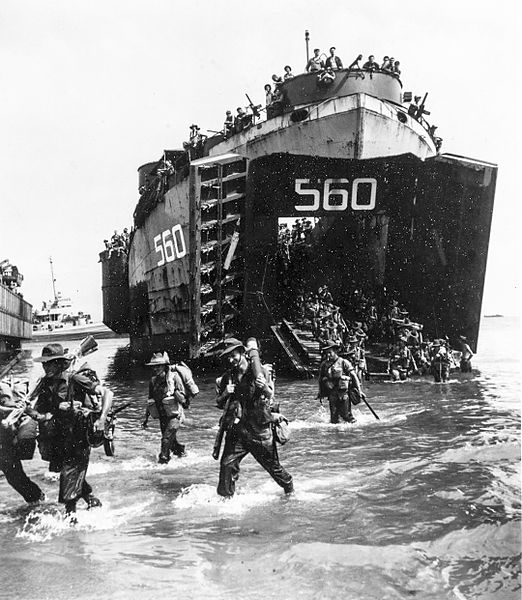
Australian troops land from USS LST-560 at Labuan on 10 June 1945.
The two infantry divisions which composed the Ist corps, 7th and 9th, were under overall supervision of the 8th Army commander, Douglas Mc Arthur. The Australian objective, after Borneo, was in the long run, the liberation of Singapore. The Australians were carried and covered by the U.S. 7th Fleet under Admiral Thomas Kinkaid, comprised of several task forces. During the operation, the RAAF would play an important role, notably the Australian First Tactical Air Force and elements of the Thirteenth Air Force.
The very first phase on 1 May 1945 was to land on the small island of Tarakan, north-east coast, which possessed airfields vital for future operations. The operation started on a stealth side, by night with Australian-built MK III folboats. The latter were folding, portable kayaks inspired by the inuits, and developed for British SOE and commandos for night raids along the French coast already. These were the Cockle series. These were collapsible boats partly made in fabric, with aluminium elements. The Folnoats started to be used during Operation Rimau (attack in Singapore harbour). At least 34 raids either recce patrols, rescue missions and other were led in the Pacific, such as COPPER, PYTHON, PLATYPUS and SUNCHARLIE. When the attack on Tarakan started, Instructors to the Australians had plenty of experience. The Australian night mission was to make a recce of Djoeta oilfields.
When the main invasion commenced, it was covered by the guns of three cruisers, seven destroyers and support landing crafts of the rocket and gun types. Minesweepers also cleaned the area. Most of the amphibious ships deployed for the main assault was of US-construction, part of the 7th Fleet. The Australians massively used the LSI and LSTs. The last Japanese stronghold fell the 20 of June, but casualties has been heavy.
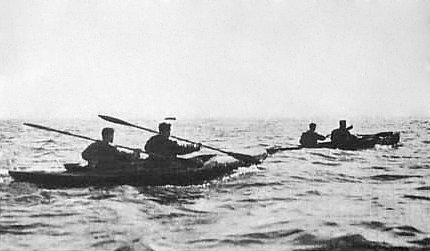
Cockles Mark II, Operation Frankton
The second phase implied landings on the North-West of Borneo, for the capture notably of Labuan. On the 29,000 Australians that participated, about 1,000 combined were either US and British forces. The main objectives were to secure Brunei Bay area and seize the oil fields and rubber plantations of the region. It was preceded again by a night recce raid and would be covered by a large fleet of American and Australian warships. On 10 June 1945 were launched simultaneous assaults by the 24th Brigade (Labuan island) and 20th Brigade (coast of Brunei). The operation would last into early August, and meanwhile Special Operations Australia (SOA) organized an interior guerilla.
The last great push was at Balikpapan on 1 July 1945. The town and port were captured on 3 July. The landings were to be preceded by 20 days of intense bombardment, by ships and air, which was widely criticized afterwards and the island lacked facilities and was primitive, and the latter were destroyed for the most. So the whole operation (which costed 2,100 casualties to the Australians and allies) was reduced to the mere occupation of an outpost. It would take months before the oilfields and rubber plantations were back in operation and networks reconstructed and by that time the war was over. Indeed, the last pockets of resistance were still active in September 1945.
Operation Zipper (September 1945)
Also called Operation Slippery: It was part of the grand campaign to liberate Malaya and Singapore. However there were readjustments due to insufficient resources.
In the end, it was never led as intended and in its place scaled down into Operation Tiderace (liberation of Singapore) and Operation Jurist (liberation of Penang). Operations Jurist and Tiderace happened following the surrender of Japan and Penang and Singapore fell rapidly with little or no resistance. This was followed by smaller amphibious landings at Selangor and Negeri Sembilan. Informed IJA garrisons just surrendered without a fight, but small pockets of die hard Japanese would resist for longer. These operations were covered by the Royal Navy’s Task Force 11. That was the last time British Amphibious ships operated this way. The next months, after occupation was solidified, and years, these ships (the larger ones) would carry back home British Troops, Australian and New Zealand garrisons all over the Pacific.
Operations Olympic/Coronet: Operation Downfall November 1945/March 1946
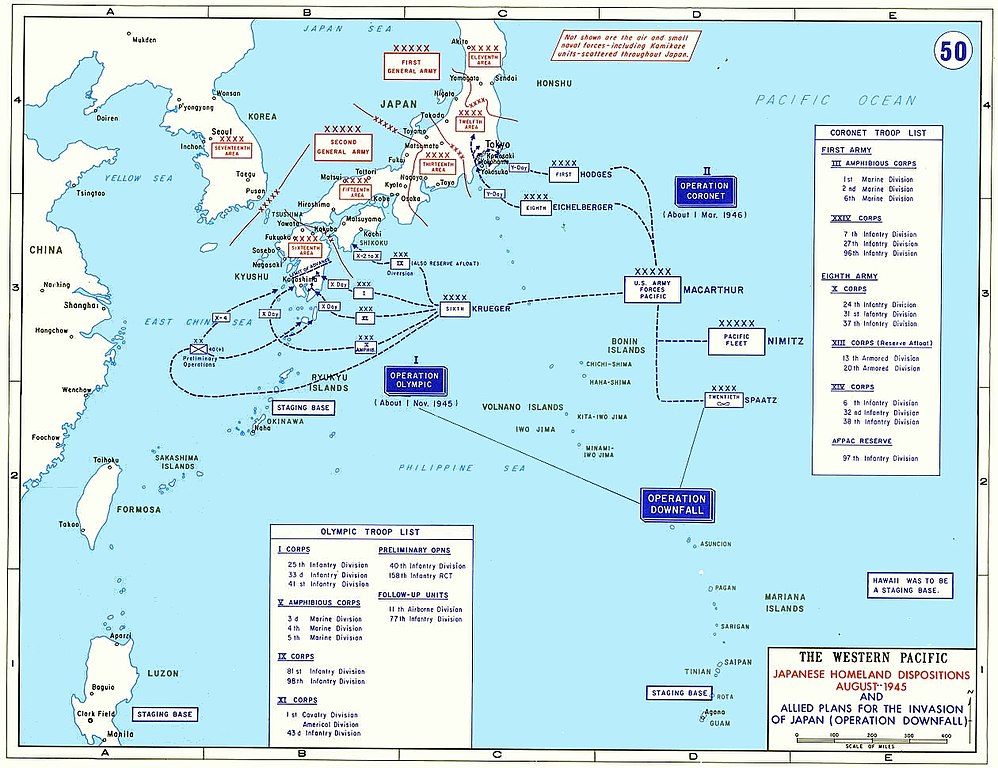
Probably in scale the largest allied landing operation of the war, Operation Olympic was never executed. As we know, both nuclear attacks on Nagasaki and Hiroshima in August and the Soviet declaration of war and invasion of Manchuria urged a decision by the civil authorities of Japan, backed by the Emperor and against the Army staff, to declare a cessation of hostilities and surrender of all forces in the Pacific and far east. That was fortunate for the allies, notably the British, Australian, Canadian, New Zealander and Indian troops which would have been part in the landings, as the number of casualties estimated for the conquest of mainland Japan was to be as wide as 500,000 to one million combined from both sides, and much more by adding the Japanese population forced into militias.
A bit like the large land combined operation (and crossing of the Rhine) of 1919 that would have led the entente into the heart of Germany and to Berlin, which never happened, the invasion of Mainland Japan stayed on paper. This was the culmination of so many efforts from 1942. It was postponed and planned for October 1945, then November 1945 and was to last well into 1946. The scale was daunting. The Commonwealth Corps combined around one million men in total with all personal, notably the fleet, air support and ground troops. The US were to commit five million men. They faced 4,335,500 military personal reinforced by hundreds of tanks never sent in China or the Pacific, and 31,550,000 civilian conscripts, armed with anything from old rifles to mass-produced pistols, explosives and bamboo lances. The scale of death and destruction met recently at Okinawa was a stark reminder of the Japanese fanatic level of resistance and expected losses.
The main landings would have taken place at Kyūshū (the southernmost island of Japan) and the beaches of the Kantō plain (southwest-southeast of Tokyo) in order to gain a sold foothold in the southernmost island and to take as rapidly as possible the capital. Operation Coronet was the attack on Tokyo Bay itself (Y-Day) while before that, Operation Olympic was the invasion of Kyūshū. For this, “X-Day” was scheduled for 1 November 1945. The cover force was to comprise 42 aircraft carriers, 24 battleships, and 400 destroyers and destroyer escorts and 13 divisions were to land. It was to be preceded by preliminary operations in October, to turn the islands of Retto and Koshimi, east and Tanega Shima south into airfields and support bases.
In this, the British and commonwealth forces were due to commit their British Pacific Fleet (part of Third Fleet), comprising 6 fleet and light fleet carriers, covered by a strategic heavy bombing component, called the Tiger Force (detached from RAF Bomber Command) with some 480–580 Avro Lancaster, many converted as flying tankers, and the Australian First Tactical Air Force with some 20 fighter-bomber squadrons. At Coronet later (Tokyo), the Commonwealth forces were to engage under Lt. Gen. Charles Keightley, the 3rd Infantry Division (United Kingdom), 6th Infantry Division (Canada) and 10th Infantry Division (Australia).
Read More/Src:
Sites/links
Conway’s all the worlds fighting ships 1922-47 p.72-77
ONI landing crafts and ships
Hstory.navy.mil Combined Operations Craft booklet 1942, with many plans and characteristics
The Role of Amphibious Warfare in British Defense Policy By I. Speller
https://history.army.mil/books/wwii/MacArthur%20Reports/MacArthur%20V1/ch11.htm
https://weaponsandwarfare.com/2015/10/25/landing-craft-gun-lcg-and-landing-craft-tank-rocket-lctr/
http://www.navypedia.org/ships/uk/uk_amphibious.htm
https://www.combinedops.com/LST%20HMS%20Misoa.htm
http://www.materielsterrestres39-45.fr/fr/index.php/barges-de-debarquement/200-barge-de-debarquement-etats-unis/377-lcm
http://pwencycl.kgbudge.com/L/c/LCPR_class.htm
http://ww2today.com/10th-july-1943-the-commandos-seaborne-assault-on-sicily
Books
Balkoski, Joseph (2004). Omaha Beach.
Balkoski, Joseph (2005). Utah Beach.
Belchem, David (1981). Victory in Normandy.
Breyer, Siegfried & Koop, Gerhard (1978). Die Schiffe und Fahrzeuge der deutschen Bundesmarine 1956–1976
Bruce, Colin J. (1999). Invaders.
Buffetaut, Yves (1994). D-Day Ships.
Campbell, John P. (1993). Dieppe Revisited: A Documentary Investigation.
Chappell, Mike (1996). Army Commandos 1940–45.
The Chief of Combined Operations (1945). Combined Operations Staff Notebook.
Delaforce, Patrick (1998). Churchill’s Secret Weapons.
Dunphie, Christopher & Johnson, Garry (1999). Gold Beach.
Fergusson, Bernard (1961). The Watery Maze: The Story of Combined Operations.
Ford, Ken (2003). Dieppe 1942: Prelude to D-Day. Oxford, UK: Osprey Publishing.
Futter, Geoffrey W. (1974). The Funnies : The 79th Armoured Division and its specialised equipment.
Hall, Tony (2001). D-Day: the strategy, the men, the equipment
Keegan, John (1992). Six Armies in Normandy.
Ladd, James D. (1976). Assault From the Sea: 1939–1945.
Ladd, James D. (1978). Commandos and Rangers of World War II.
Ladd, James D. (1982). Royal Marine Commando.
Lavery, Brian (2009). Assault Landing Craft.
Lund, Paul & Ludlam, Harry (1976). War of the Landing Craft.
Maund, L. E. H. (1949). Assault From the Sea.
Milne, Gilbert A. (1960). H.M.C.S. : One Photographer’s Impressions of the Royal Canadian Navy in World War II.
Montgomery, Bernard Law (1949). El Alamein to the River Sangro.
Otway, T. B. H. (1990). The Second World War 1939–1945.
Porch, Douglas (1991). The French Foreign Legion.
Robertson, Terence (1967). The Shame and the Glory: Dieppe.
Saunders, Hilary A. St. George (1943). Combined Operations: The Official Story of the Commandos.
Thompson, R.W. (1957). At Whatever Cost: The Story of the Dieppe Raid.
Tooley, Robert (1989). Invicta.
U.S. Navy (1944). ONI 226: Allied Landing Craft and Ships.
U.S. War Department (1945). Omaha Beachhead.
The models corner
https://www.dantaylormodelworks.com/landing-craft-mechanized-mk-3-78-p.asp
Trumpeter TRU00347 Model Kit, Various
Revell 03000 Limited Edition – D-Day June 6 1944 – LCM3 Landing Craft
Trumpeter TRU07213 Model Kit LCM 3 USM
Italeri 510006524-1:35 LCVP
LCVP Landing Craft Vehicle Personnel w/Figures 1/72 Heller
Accurate Armour’s kit S17: LCF(4) Landing Craft Flak
Accurate Armour’s S13 kit: LCT(4) Landing Craft Tank
Millicast:
LCP(L) Landing Craft Personnel (Large)(Waterline Version)
LCA Landing Craft Assault (Waterline only)
LCI L Landing Craft Infantry (British version)(Large) (Waterline)
LCMI Landing Craft Mechanical Mk.I (Waterline only)
Armageddon models: LCA, LCVP 1/72
On cornwallmodelplans.uk
On Wikipedia:
https://en.wikipedia.org/wiki/Landing_craft_tank
http://www.robertsarmory.com/Higgins-Boat.htm
https://en.wikipedia.org/wiki/Landing_Craft_Mechanized
https://en.wikipedia.org/wiki/Landing_ship,_infantry
https://en.wikipedia.org/wiki/Landing_Craft_Assault
https://en.wikipedia.org/wiki/LCPL
https://en.wikipedia.org/wiki/Landing_Ship,_Tank
https://en.wikipedia.org/wiki/Type_C1_ship
https://en.wikipedia.org/wiki/Gold_Beach
https://en.wikipedia.org/wiki/LCM_1
https://en.wikipedia.org/wiki/LCM_(2)
https://en.wikipedia.org/wiki/LCVP_(United_States)
https://en.wikipedia.org/wiki/Lake_tanker
https://en.wikipedia.org/wiki/HMS_Sainfoin_(F183)
https://en.wikipedia.org/wiki/List_of_ships_and_craft_of_Task_Force_O
https://en.wikipedia.org/wiki/Royal_Marines
https://en.wikipedia.org/wiki/List_of_amphibious_warfare_ships_of_the_Royal_Navy
https://en.wikipedia.org/wiki/Amphibious_warfare_ship
https://en.wikipedia.org/wiki/Borneo_campaign_(1945)
https://en.wikipedia.org/wiki/List_of_amphibious_assault_operations
Nomenclature of British Landing Crafts & ships
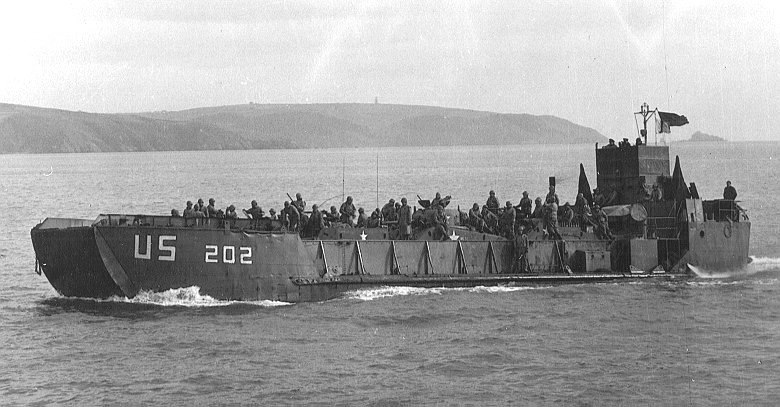
LCT 202
The British (and commonwealth) amphibious was constituted along the need of amphibious operations from late 1941 up to 1944 when all types were settled. In all, about 5,000 (roughly 4780) vessels built in UK, many never completed as the war ended. In addition, the US provided under lend-lease some additional 13 LSI(L) modified by the British, four LSDs, 115 LST(2), 220 LCI(L), 172 LCT(5) and two LT(6). The British in addition converted many ships to special tasks like the LCT(R)(2) and (3), gun and FLAK. The bulk were small LCA, LCP, LCV, and LCM types. For the latter, the major difference was their all-steel construction, whereas US-built Elco types and assimilated were wooden boats.
Assault types were more diverse as various ships types were requisitioned. When there was enough of a single class, this made an homogeneous types. USN assault ships were derived from standard mobilization freighters, with a larger degree of standardization. The British also produced arguably more specialized types of assault ships, with guns and rockets for support. More importantly, they pioneered the bow doors LSDs with the HMS Misoa class, former tankers used for the first time in November 1942. They were followed by the first purpose-built LSDs, the Boxer class, ordered in March 1941. The parallel development of the LST, initiated by Churchill’s LCT orders in late 1940, emerged from December 1941 with a request to the Bureau of Ships, put in charge to design plans for a derivative of from K.C. Barnaby design (Thornycroft). The US LST(2) integrated Sir Rowland Baker’s experience with British LCTs, while its final design was authorized by the Congress on 6 February 1942. The first was laid down on 10 June 1942, and they were in action during Operation Torch. The development of landing crafts and ships went also with doctrines and similar arrangements on assault ships, with lots of exchanges of practices between the allies, to the point of interoperability.
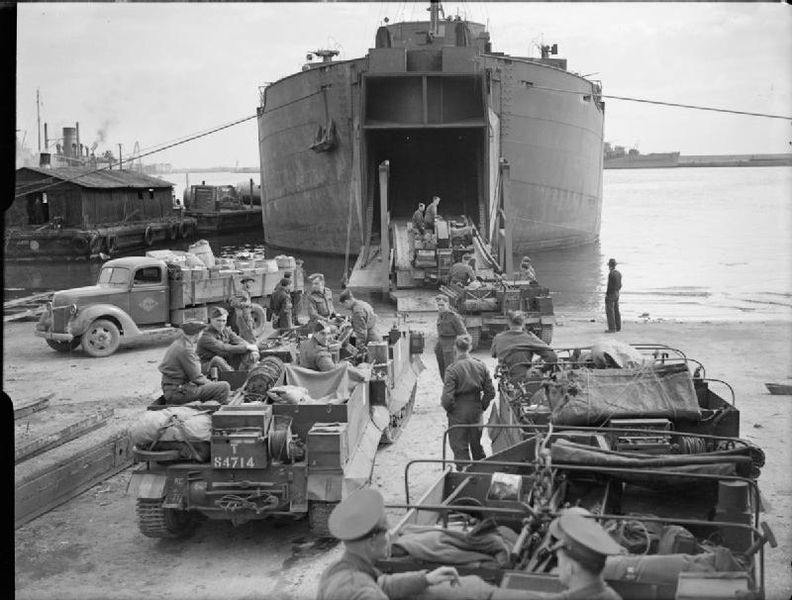
HMS Bachaquero at Bône, FNA, December 1942.
LSI(L) class landing ships infantry (Large)
Class: HMS Ard Patrick, El Hind, Glenearl, Glengyle, Glenroy, Kanimbla, Karanja, Keren, Manoora, Persimmon, Westralia
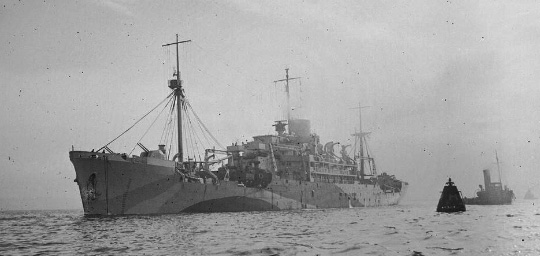
HMS Glenroy (IWM)
This diverse array of ships was placed into the same class due to their displacement of about 8,000-10,000 tonnes GRT.
Of the same type were the three “Glen” which were recent, 1938-39, Diesel-powered, 18 knots and Karanja, Keren (1930) VTE-powered, and were all displacing around 9800 gross tonnes.
The smaller one was El Hind (5319 tonnes GRT) Ard Patrick (7526 tonnes GRT), both with VTE engines and 14 knots, 1938-39. Manoora was the largest, 10856 tonnes GRT; diesel and 16 knots.
Three were used by the RAN: Kanimbla, Manoora and Westralia.
Armament was very diverse. The table below shows both it and the military load.
-Ard Patrick: 1-4.7 in, 1-12 pdr. 18 LC, 2 LCP(R), 800 troops
-El Hind: 1-4.7 in MkV. Same
-Glenearl, Glengyle, Glenroy: 6-4in Mk.XVI. 24 LCA/LCS(M), 3 LCM, 1089 troops.
-Kanimbla: 1-4 in, 2x 3-in. 10 LCA, 1380 troops.
-Karanja, Keren: 1-6 in, 1-3 in. 9 LCP(L) and one LCS(M), 2 LCM, or 2 LCP(L), 2 LCM, 9 LCA, 1300 troops
-Manoora: 2-4 in mk XIX, 2-3 in. 8 LCA, 4 LCM(1), 1230 troops
-Persimmon: 1-4 in; 1-12 pdr. 18 LCA, 1 LCM, 1630 troops
-Westralia: 3-4 in Mk XIX. 18-24 LCA, 930 troops
In addition, thirteen US lend-lease ships were also converted: They ranged from 6711 to 7080 tonnes GRT, built in 1943. They able to reach 14 knots with 676 tones of oil. They were armed with a single 4-in Mk.XIX and one 12-pdr. They carried 18 LCA, 2 LVC(P), 1 LCS(M) or LCM and around 898 to 1458 troops. They were renamed in RN service HMS Cicero, Donovan, galteemore, Ormonde, Rocksand, Sainfoin, Sansovino, Sefton, Silvio, Sir ugo, Sir Visto and Empire Broadsword and Javelin. They were detached to the ministry of war transport.
All these ships were classed in the naval registry, but much more has been converted at various degree to carry troops and landing crafts, still under merchant command and are not listed here. Proper assault ships were armed and modified to handle a large number of landing crafts. The Glen class were probably the mos advanced of these, with no less than 14 crafts either side suspended under luffing davits and gravity davits (the majority). The troops climbed into these when lowered to waterline in order to not overload the structure. However using nets to climb into these vessels was a risky proposition, moreover in heavy weather. Troops fell in between the hull and landing crafts could would be crushed to death. Many other drawn due to the weight of their equipment.
Four of these ships were lost: HMS Karanja bombed in 12 November 1942, El Hind, burnt 14 April 1944, Empire Broadsword (which hit a mine in July 1944) and Empire Javelin, torpedoed by and U-Boat on 28 december 1944. The remainder were converted back to civilian use from 1946.
LSI(M/S) class landing ships
HMS prince Baudoin, Charles, David, Henry, Leopold, Philippe, Albert, Prinses Astrid, Beatrix, Joesphine Charlotte, Queen Emma.
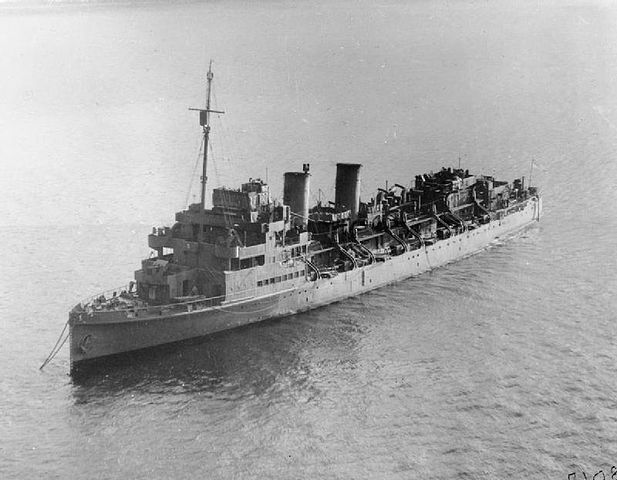
HMS Prinses Astrid
The “crowned head” serie, named after Princes and Princesses of Europe were classed as LSI(M) or Landing Ship Infantry Medium and LSI(S) for “small”. Indeed as the following list shows these ships were very different in size, ranging from 2950 to 6890 tonnes, and dated back from 1929 to 1939.
-HMS Princes Baudouin: 3219 GRT, 22 knots, diesel 135 tons of oil, 2 x12 pdr, 8 LCP(L)/LCA/LCS(M), 384 troops
-Prince Charles class (& Philippe, Albert, Astrid, Josephine): 2950 GRT 20.5 knots VTE 323 tonnes oil. 2 x12 pdr, as above, 270 troops
-Prince David class (& Henry): 6892 GRT, 20.7 knots VTE 1400 tons oil. 4x 4-in Mk.XVI, 8 LCA, 538 troops
-Princes Beatrix class (& Queen Emma): 4136 GRT, 22 knots 295 tonnes diesel. 2 x12 pdr, 6 LCA/LCS, 2 LCM, 372 troops.
Two of them, Prince David and Henry were former AMCs armed with 40 mm and 20 mm AA. The usual complemet was 2 pdr and 20 mm guns, and even 6 Deep Charges for local self ASW defense. Landing crafts were hoisted by gravity davits. HMS Prince Philippe was lost in a collision on 15 July 1941, off the west coast of Scotland with SS Empire Wave and Prince Leopold by an U-boat on 29 July 1944 while the rest were sold to civil companies in 1946-47. “Leopold” and “Philippe” were paid for by the British Government and new ships rebuilt in place.
LSI(H) class landing ships
HMS Brigadier, Duke of Wellington, Invicta, Isle of Guernsey, Thanet, Lairds, Royal Scostman, Ulsterman, St Helier, Ulster Monarch.
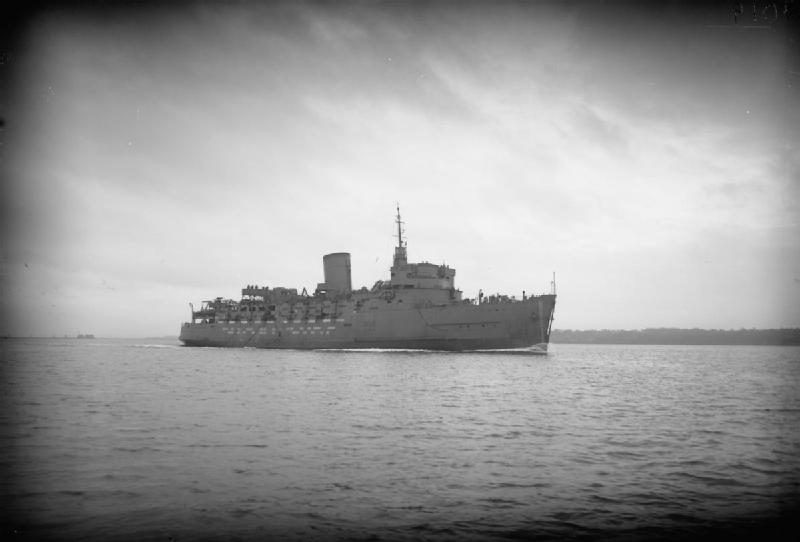
HMS Invicta
Relatively similar in concept to the LSI(M/S), but the “H” stands for “hand”. Meaning their davits were hand-operated (hydraulic-electric in the previous class) or under projected spurs. They are very diverse and it’s almost impossible to class these Ferries into subclasses. They completed their battery by 20 mm AA guns Oerlikon. Dating back 1911 to 1939, they all survived the war.
In displacement, they ranged from 1783 GRT (HMS Laird Isle), to 4178 GRT (HMS Invicta).
Three were proppeled by diesels (Scotsman, Ulsterman, Monarch), the other VTE, speed ranging from 16 to 22 knots (Invicta). Two burnt coal.
Armament-side, they carried either a single 12-pdr, or single 4-in gun Mk.XIX. Carrying capacity was the same: 6 LCA, 420-580 troops.
LSS class landing ships
HMS Daffodil, Princess Iris.
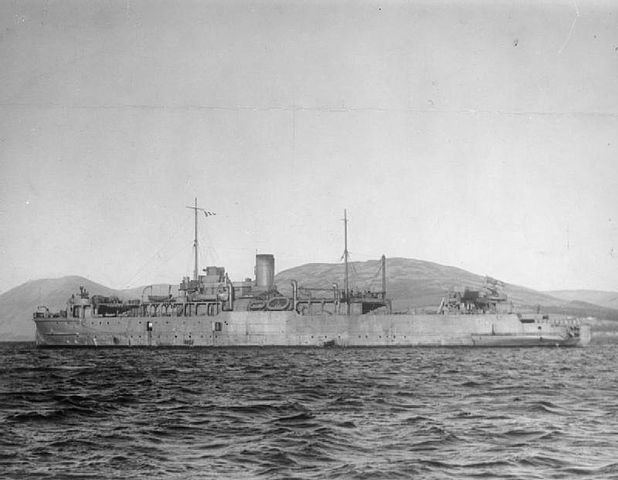
Only two ships were concerned by this acronym, which stood for “Landing Ship, Stern chute.”
They shared nothing with the 1906 Royal Daffodil and Royal Iris which participated to the famous Zeebruge raid in 1918; Both were 2678-1683 tonnes GRT vessels (SS train ferry N°2 and 3) launched in 1917 at Fairfield Govan. They were capable of 11.5 knots and carried 279 tonnes of oil.
They were former train ferries with a deep load draught of 9ft 8 in or 10ft 4in, with room all along the hull, either side of the central island to make room to rails. Reconfigured as a landing vessel, 14 LCM(1) or 11 LCM(3) could be carried and they were armed with four single 2-pdr (40 mm AA) and five 20 mm Oerlikon AA. The load was later modified for 13 LCM(1), or 9 LCM(3) plus 50 MT vehicles of 7-1/2 tonnes and 105 troops. From their conversion in 1941 they took part in several operations and HMS Daffodil hit a mine and sank in 18.3.1945 off Dieppe.
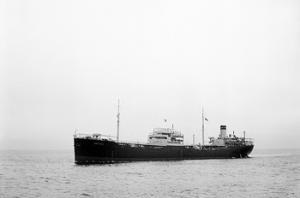
LSG class landing ships
HMS Derwentdale, Dewdale, Ennerdale (1941)
LSG stood for “Landing Ship, Gantry”. Indeed the “Dale” class ships were formed RFA oil tankers converted during construction in 1941. The gantries were designed to hoist LCM(1)s each with a 10 tonnes load, so enough to carry two platoons and their equipments. They carried 15 of them and 266-280 troops. Their light AA comprised three single 2-pdr Bofors guns, and six 20 mm oerlikon AA in addition to their main 4.7 in gun. The first two displaced 16750 tonnes and were propelled by diesel engines at 11.7 knots, with 728 tonnes of diesel fuel while the third displaced 16.798 tonnes and had a VTE steam engine for 11 knots with 1450 tonnes of oil. Deep load was limited to 23 feets to provide sufficient freeboard and there was plan tp convert them also as water carried (3000 tonnes). They served well after the war in the Royal Navy, discarded from 1959. Their transformation indeed was not reversible.
LSC class landing ships
HMS Empire Charmain, Empire Elaine (1942)
It was tempting to convert some of the numerous British-built Empire class freighters into assault ship. The two Empires 7512 tonnes vessels were modified during construction to handle deck-carried LCMs (21 of them), using large derricks. For this reason they were denominated “Land Ship, carrier”. In addition they carrid 323 troops and were defended by a single 4-in gun and possible 2-3 20 mm Oerlikon guns. Both had a diesel and were capable of reaching 11.5 knots. Both operated for the British-India Steam Navigation Co Ltd and took part in two large convoy missions.
LSD class landing ships
These were four ex-US standard LSDs (“Dock”), one of the very first, provided under leand-lease: HMS Eastway, Highway, Northway and Ocean way, ex-LSD 9, 10, 11 and 12. They were returned to the USN in 1946.
LST class landing ships (Misoa class)
HMS Bachaquero, Misoa, Tasajera (1938)
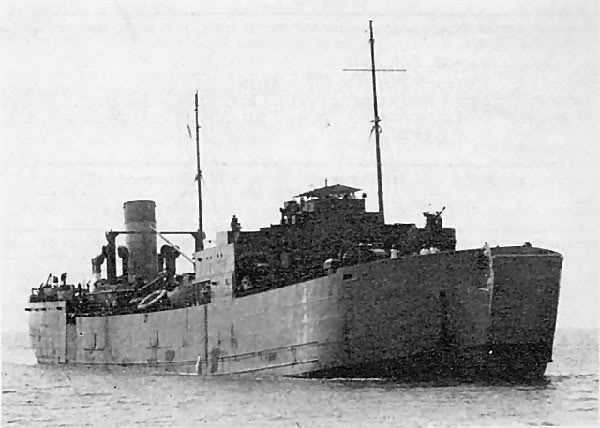
HMS Bachaquero – credits combinedops.com
Probably the most famous ans earliest British LSTs (“Tanks”). These were 6455/5680 tonnes for 382ft in length shallow-draught oil tankers trading from lake Maraicaibo. They were slow 8.25 to 10 knots, steam powered, carrying 660 to 950 tonnes of oil. Dating back 1937-38 they were taken in hands in 1941 and converted with a bow ramp to be beached and unload eighteen 40 tonnes medium tanks (M4 Sherman, M3 Grant) OR twenty-two 25 tonnes light tanks (Stuart) or 33 military trucks and 197-207 troops. Their onboard armament comprised two 4-in smoke mortars for close support and 11 to 26 x 20 mm Oerlikon AA guns. Bachaquero, the first converted had three 2-pdr guns instead.
We are going to delve more deeper in these ships in a future post. Many saw them as a prototype for USN LSTs as well. They all survived the war and were converted back to civilian used from 1945.
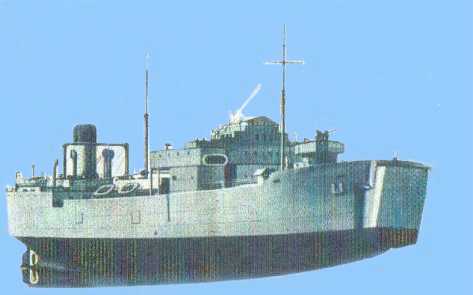
Drawing of a Misoa class ships, showing the particular shallow draught underbelly. credits combinedops.com
LST(1) class landing ships (Boxer class)
HMS Boxer, Bruizer, Thruster (1942)
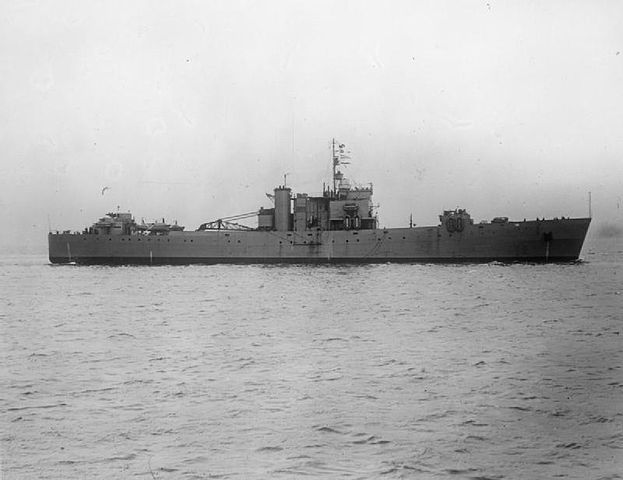
Built at Harland & Wolff, these were the first allied purpose-built Tanks landing ships. Their funnel was placed on starboard to free the tank deck. Their bow ramp was extended by 145 feet long.
-They displaced 3616 tonnes initially, 5970 tonnes Fully Loaded
-They measured 118,87 x 14.94 x 5.61 m (1.52 fwd, 3.96 aft) or 390ft x 49 ft x 5ft fore, 13ft aft
-They were propelled by two Parsons Geared turbines for speed, fed by two Forster Wheeler boilers, 7000 shop total and 16.25 knots. They carried 1728 tonnes of oil.
-They were armed with tw 4-in smoke mortars and twelve 20 mm AA
-They carried 1 LCM/LCS on deck and thirteen Sherman tanks or twenty lighter tank while 27 3-tonnes lorries were stacked on the upper deck. When the main deck was free, a ramp was lowered to help them access it. This was the concept used on LSTs, but they were not suitable for mass production and could not beach on sufficiently shallow waters. Boxer became a fighter direction ship in 1944, radar TS in 1947 while Bruize was sold in 1947 and Thruster became the Dutch Pelikaan.

Profile of the HMS bruizer (src navypedia)
LST(2) class landing ships (Lend-Lease)
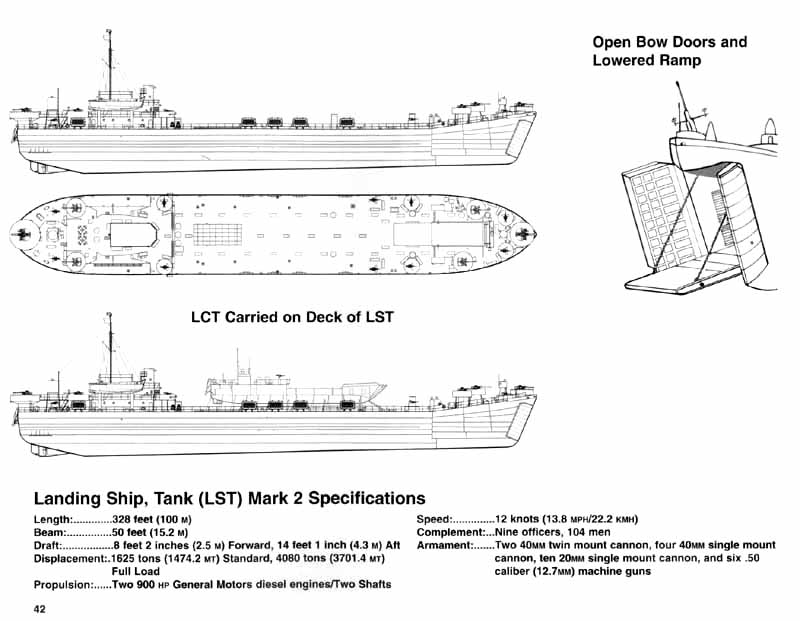
These ships were basically lend-lease standard, American-built LSTs: In all 115 were delivered (see the LST article), and 14 were lost in operations. They were rearmed by British 12-pdr (single gun) and generally armed with six 20 mm oerlikon or Poslten guns. They served at D-Day but seemingly not on Italy.
These US built ships integrated ideas from Sir Rowland Baker’s experience with LCTs. The design development was ordered on 6 February 1942 and the first keel was laid down on 10 June 1942 at Newport News. In British service the other name was LST Mark 2. Twenty-three were in service by the end 1942 and prduction ramped up steadily until 1945. The British used them after V-Day in the far eastern front. In addition to trucks, regular Sherman M4 and M3 Stuart, the British carried Crowwell, late Crusaders versions (early landings) or specialized Cavalier and Centaur tanks.
LST(3) class landing ships, Tank Mark III (1944)
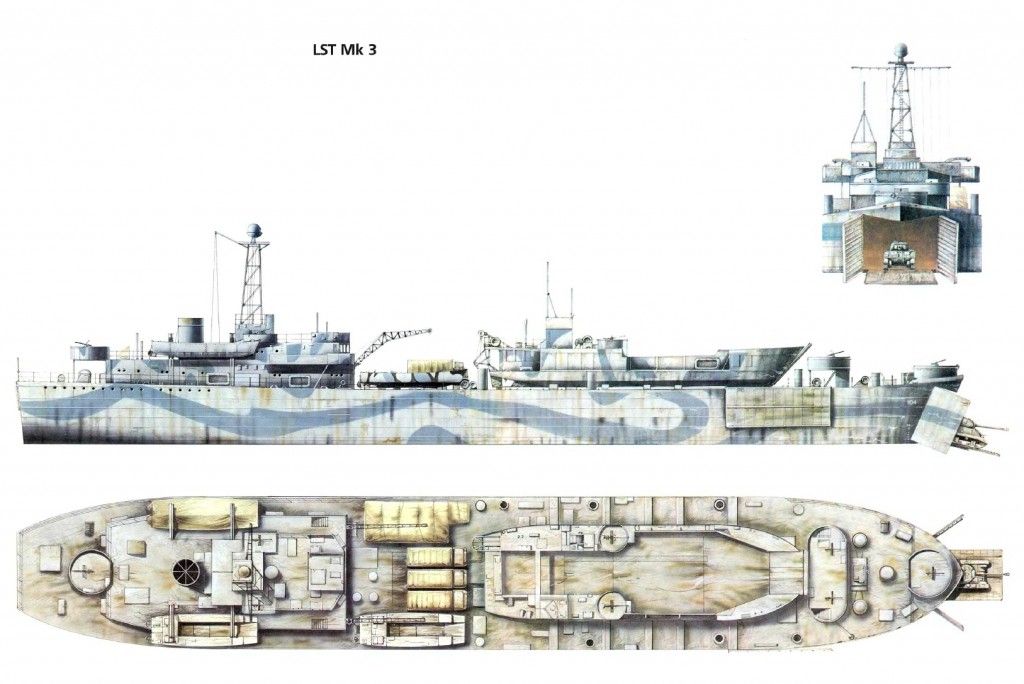
Illustration of LST Mk.III – from Pinterest, assault ships of WW2 src
-These were basically British-built versions of the American standard LST. They were numbered 3001 to 3045, but 3004-05, 3018, 3023, 3032-34, 3039 and 3045 were cancelled in 1945 or completed after the war as merchant ships. Canada also participated in the construction. The Canadian ships were the 3501-3537, but 3521, 3526-31, 3533, and 3535-37 were cancelled or also not completed as LSTs. Due to the alck of weilding facilities and diesel engines, they differed from US LSTs as being heavier. From 1947, many received names of former lend-lease escort carriers and they setayed in service well into the 1970s.
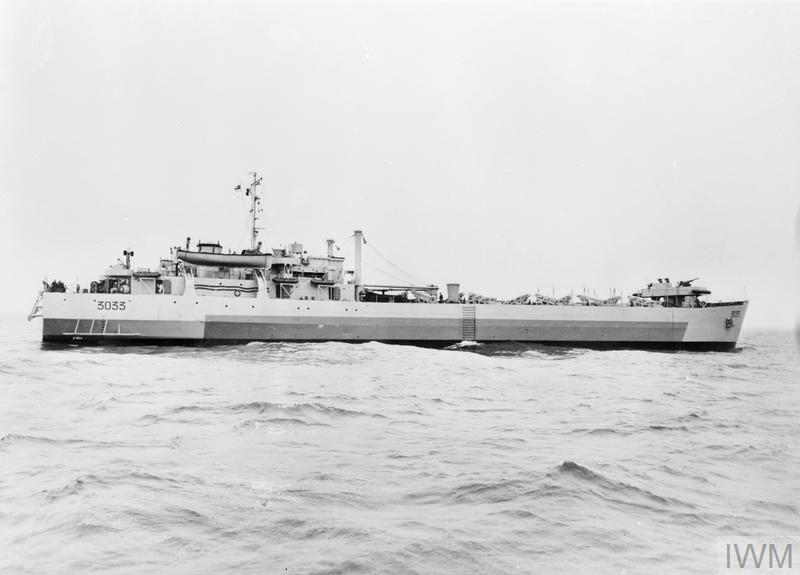
Variants
LST(A):
-Some LST(3)s were converted to LST(A) (for “assault”). The hull was stiffened so they could carry Churchill infantry tanks. I was an obligation for the Hobart’s Funnies that were launched on the beaches to clean up mines, Churchill AVRE or Sherman BARV and the like.
LST(C):
-Two LST(3)s were converted to command vessels, called LST(C): LST 3043 and LST 3044, renamed after the war HMS Messina (L112) and HMS Narvik (L114). Their deck was kept free to possess in total ten 20 mm Oerlikons and four 40 mm Bofors. Over time they were modified to carry the 112 feet (34 m) long LCT5 or LCT6. They were in fact improvized LSDs (Docks), with the main bay flooded with “launch ways” obtained by slacking off bolts in the wedge blocks, the hull being carefully heeled over about 11 degrees. Later they carried extra LST(3)s during completion and LCM(7). They were hoisted on by means of a special 30-ton derrick, later replaced by a 15 tons model. LCM(7)s were landed on trolleys fitted with hydraulic jacks.
LST(Q)
-Two LST(3)s were also converted as Headquarters command ships, called LST(Q). L3012 (later renamed L3101 and HMS Ben Nevis) and LST 3013 (LST 3102 later HMS Ben Lomond). These LST “mother ships” were very similar in concept to the LST(2) with two Quonset huts erected on the main deck for 40 officers. Deck berths were built for an extra 196 men, a bake shop and 16 refrigeration units for fresh food also provided for the crew and more, as well as four extra distilling units, with the ballast tanks converted for fresh water.

Cutaway of an LST(3) – ONI
Specifications:
-Displacement: 2,300 tonnes standard, 4,980 tonnes FL
-Dimensions: 105.92 x 16.84 x 3.79m
-Machinery: 2 shaft VTE 2 admiralty 3-drum boilers 5,500 ihp 13.5 knots, oil 1400 tonnes
-Armament: 2 twin 40 mm Bofors, 6x 20 mm AA.
-Capacity: 15 -40 tonnes medium tanks (Sherman & Cromwell), or 20 -25t standard (Stuart and others) and 14 -3 tonnes lorries, 170 troops
-Crew: 118-190.
LSH(L) class landing ships
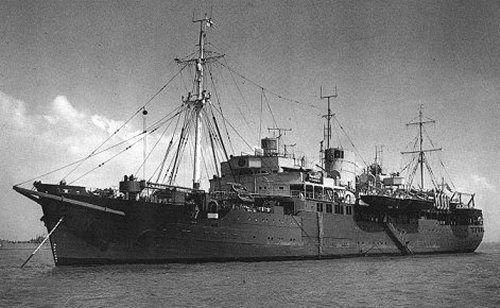
HMS Bulolo
Landing Ship, Headquarters, Large: These were five converted ships tailored for amphibious operations. They acted as Naval HQs. They had extensive communications equipments. They were the former AMCs Bulolo, OBV Hilary and Largs, the LSI(L) Keren and ex-City of Edinburgh 8036 tonnes GRT 1936 liner HMS Lothian. Armament diverged, the latter had four 4-in MkXIV guns, twenty 20 mm AA guns, and the others diverged: HMS Bulolo had had five 40 mm, eleven 20 mm AA, Hilary had a 3-in, four 2-pdr, 13 x 20 mm AA and HMS largs 14. HMS keren had eight 40 mm Bofors and 14 20 mm AA.
LSF class landing ships
For Landing Ship, Fighter Direction. Eight ships, quite diverse were requisitioned and transformed as HQs for the RAF and allied air forced in the area of the landings. These conversions concerned the ex HMS Boxer (LST(1)), three LST(2), the convoy escort HMS Antwerp, auxiliary AA vessels HMS Ulster Queen and Stuart Prince. The later was 1948 tonnes GRT; 12 knots coal-burning freighter built in 1940. She was armed with 24 x 20 mm AA guns. HMS Ulster Queen had four 4-in Mark XVI, ten 20 mm and fourteen DCT, and HMS Boxer after conversion had two quadruple pom-Pom Bofors 40 mm guns and twelved 20 mm AA guns. HMS Palomares had two quadruple Pom-Pom and twelve 20 mm AA guns; LST 216 was lost in 1944 and Palomares badly damaged by a mine on 21 January 1944; repaired for 14 months so that she narrowly missed the end of the war.
LCI(L) class landing crafts
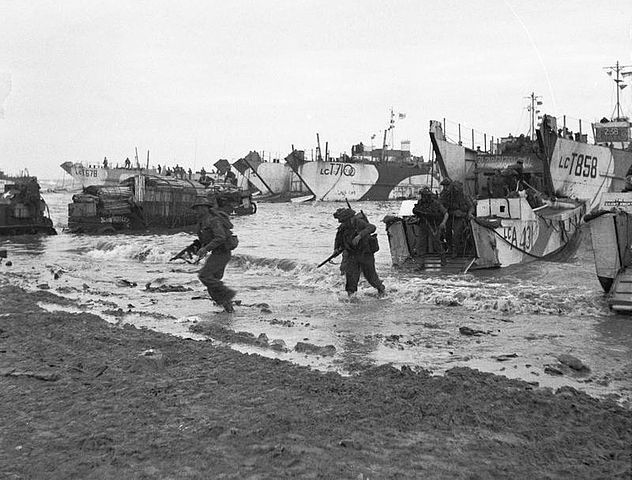
-The LCI(L) – Landing Craft, Infantry, large were lend-lease LCIs of US construction, 220 of them. Twenty were altered to LCH, or hospital ships for local HQ services and ten lost in action. In British service they had one 2-pdr gun and three 20 mm AA guns.
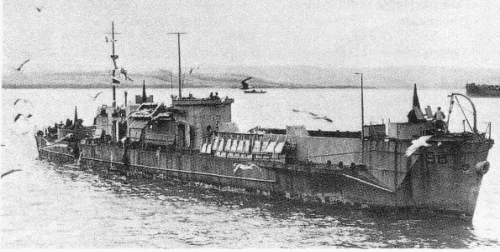
Lend-lease US-built LCI(L) MoD (Conway’s)
LCI(S) class landing crafts
-The LCI(S) – “Small”. Numbered 501 to 600, these were British-built, modified Fairmile “H” boats, protected by an extra 1/4-inches stell plating applied in scales on the superstructure for extra protections. This was an immediate result of the lessons learned in the onlyu two raids where these boats were used, disastrous, like at Dieppe. Eight were lost during the war.
Specificatons LCI(S):
Displacement: 110 tonnes loaded
Dimensions: 32.03 x 6.53 x 1.08 m
Machinery: Two shafts Hall-Scott petrol engines, 840 bhp 14.5 knots petrol 4000 gallons
Armament 2-8 x 20 mm AA guns, 17 crew, 102 troops.
LCS(L)2 class landing crafts
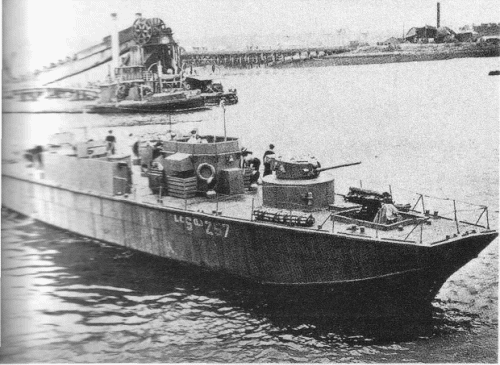
LCS(L)2 support light Mark II – MoD (Conway’s)
Based on the former, these were ten conversion taken on the stocks to be converted as support crafts. Numbered 251 to 260, they were armed with a single 6-pdr/7cwt Mark V, the whole Valentine tank turret in fact, installed on a raised barbette on the forward deck, with two 20 mm AA and two 4-in smoke mortars, displacing 116 tonnes. Complement was 25.
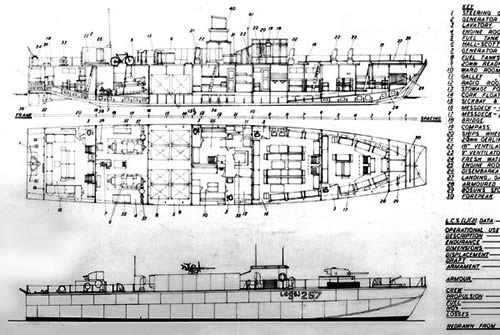

LCT class landing crafts
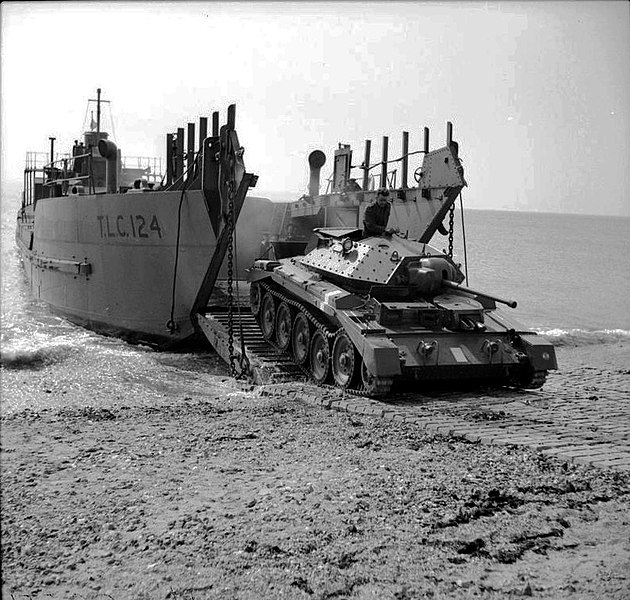
In all, Eight series of Lancding Craft, Tanks were built for a total of 1216 ships, plus 174 Land-Lease US-built ones. Until 1945, they were deployed in all British amphibious operations including tanks outside LSTs. They were many conversions as well, the LCF (“Flak” – AA ships), LCT(R) of close support with rocket launchers, and LCG of artillery support with surplus destroyer guns.
LCT(1) landing Craft, Tank Mk.I (1940-41)
These thirty ships were named Landing Craft tank and several series were devised in UK early on.
-The initial serie in late 1940 was called LCT(1). These first ships were given a cellular steel construction and could be split up in four sections for easy transport. They were short range vessels indeed. On the 30 built, half were sunk during the war, an heavy tribute to the British amphibious operations. They were propelled the same was as the Fairmile C boats, with extactly the same engines, but due to the heavier weight, much slower as well.
Specificatons LCI(S):
Displacement: 372 tonnes loaded
Dimensions: 46.33 x 8.84 x 1.33 m
Machinery: Two shafts Hall-Scott petrol engines, 840 bhp 10 knots, petrol 3650 gallons
Armament 2-8 x 20 mm AA guns, 17 crew, 102 troops
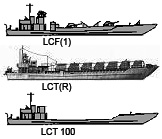
Profiles of LCTs and LCF (Conway’s via naypedia)
LCT(2) landing Craft, Tank Mk.II (1942-43)
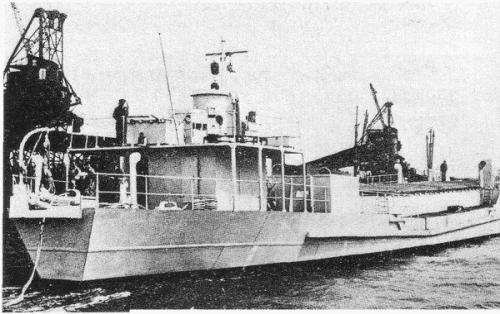
LCT(2) – MoD (Conway’s)
Numbered 100 to 172 these larger 3-shafts versions were also declined in two-shaft variants with Maxman diesels giving them 860 hp, enough for 9 knots but a superior range. Later some 3-shaft versions were given three Paxman diesels, for 1500 bhp and 11 knots, and 10,800 petrol gallons. They carried either three Medium Tanks such as the Sherman or seven light ones (or three tons trucks). On the 72 deployed, 19 were lost in action.
Specificatons LCT(2):
Displacement: 460 tonnes loaded
Dimensions: 48.74 x 9.45 x 1.63 m
Machinery: Three shafts Napier petrol engines, 1050 bhp 11 knots, petrol 8800 gallons
Armament 2-2 pdr PomPom, 2x 20 mm AA guns, 12 crew, 3-7 tanks, 100 troops
LCT(3) landing Craft, Tank Mk.III (1943-44)
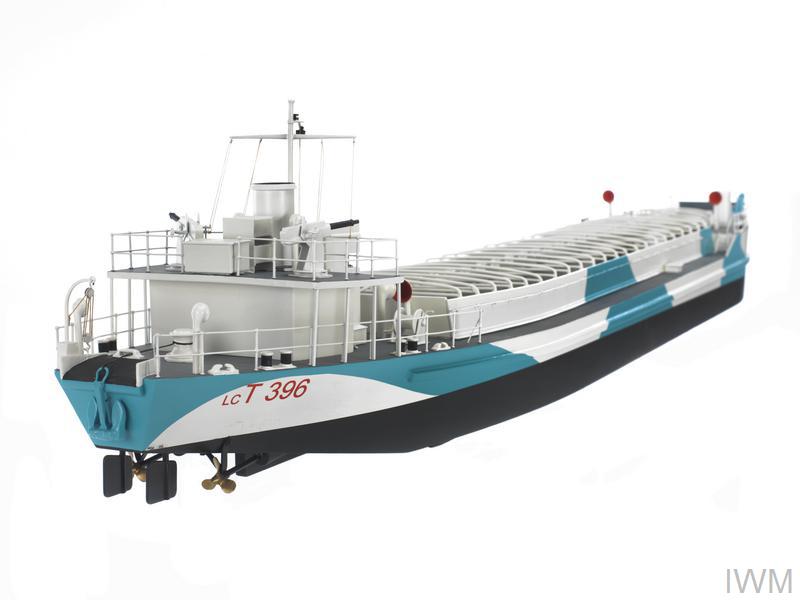
These were basically LCT(2) with an extra 32 feets section amidships. They could be disassembled in five sections for transport. They could carry either five 40 tonnes tanks like the Sherman or eleven light tanks (30 tonnes and less) of the equivalent in 3-tons lorries.
Production lasted until 1944, with a total of 200 ships, numbered 300 to 499 and 7001 to 7150.
Late production boats had two shaft sterling petrol engines for 100 bhp nd 10.85 knots and less fuel, 5760 gallons. The original carried more, but traded range for less speed. 31 were lost during the war.
Specificatons LCT(2):
Displacement: 640 tonnes loaded
Dimensions: 58.52 x 9.45 x 1.65 m
Machinery: Two shafts Paxman diesels, 1000 bhp 10.5 knots, petrol 6200 gallons
Armament 2-2 pdr PomPom, 2x 20 mm AA guns, 12 crew, 5-11 tanks, 30+ troops
LCT(4) landing Craft, Tank Mk.IV (1942-45)
These vessels were of lighter cosntruction, greater beam, and strenghtened compared to the LCT(4). They were tailor-built as gunboats for close support and numbered 500 to 1364 which gaves us a total number of 864 vessels, with 39 losses.
Specificatons LCT(4):
Displacement: 640 tonnes loaded
Dimensions: 57.07 x 11.8 x 1.36 m
Machinery: Two shafts Paxman diesels, 1000 bhp, 10 knots, fuel 11,400 gallons
Armament: 2x 20 mm AA guns, 12 crew, nine 30 tonnes tanks, 40 troops
LCT(5) landing Craft, Tank Mk.V (1944-45)
A total of 172 of these were sent via lend-lease, US-built standard LCTs. 29 were lost in action.
LCT(6) landing Craft, Tank Mk.VI (1945)
Two modified units, also supplied via lend-lease. None lost durng the war.

LCT(6) – Atlas – Osprey profile
LCT(8) landing Craft, Tank Mk.VIII (1945-47)
British landing crafts designed by Thornycroft for the far east in late 1944, which entered service from mid-1945. They were larger and more habitable, and indeed saw servivce extensively during the 1945 amphibious operations against the Japanese. They were numbered 4001-4200 but apparently only around 40-50 were completed before the war ended, the remainder after the war it seems for Conways sme were completed until 1947, but most were not (more on the cold war page).
Specificatons LCT(8):
Displacement: 810 tonnes loaded
Dimensions: 68.6 x 11.58 x 1.46 m
Machinery: Two shafts Paxman diesels, 1760 bhp, 11.9 knots, fuel 22,600 gallons
Armament: 3x 20 mm AA guns, 22 crew, eight 30 tonnes tanks, 42 troops
LCF: British Amphibious AA cover
LCF(2) landing Craft, Flak Mk.II (1943)
These two conversions were aimed at providing a consistent AA cover for the landing areas. They diverged slightly: The first displaced 455 tonnes light, mounted four twin 4-in Mark XVI DP guns, and three 20 mm AA guns. Complement was 81. The second displaced 369 tonnes light, carried eight single 40 mm Pompom and four 20 mm AA. Both had the original three shaft diesel arrangement. Both were also heavily engaged and sunk in action.

LCF(3) N°4 – Credits wrecksite.eu
LCF(3) landing Craft, Flak Mk.III (1944)
These were diesel-converted LCT(3)s converted as AA ships, fifteen in all. Displacement was 515 tonnes light and they were equipped with eight single PomPom plus four 20 mm (3-6), complement of 68, while 7-18 had four single Pompom and eight 20 mm AA and a complement of 76. Two of the latter were sunk in action.

Profile of the LCF(3) – Atlas Edition
LCF(4) landing Craft, Flak Mk.IV (1944)
These last FLAK conversion of the war were based on the LCT(4), displacing 510 tonnes, with four single 40 mm pompom and eight 20 mm, complement 76. They carried 3100 gallons of diesel fuel, augmented to 11,400 when transferred in the Far east. They were numbered 19-46 and three were lost in action.
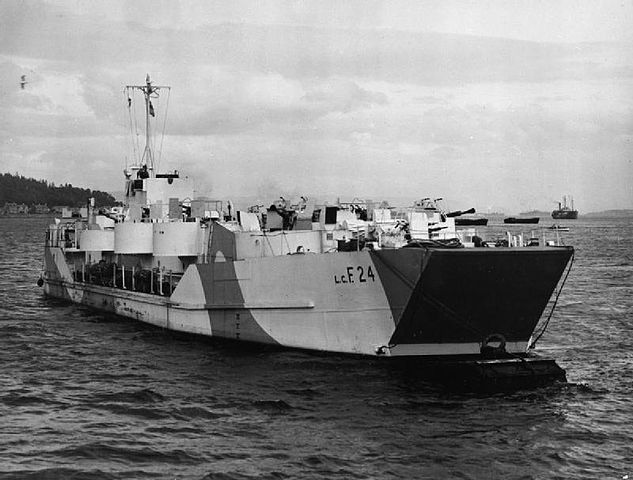
LCF(4) N°24
LCT(R): British Amphibious Rocket support

LCT(R) Mark II
LCT(R)(2) landing Craft, Tank (Rocket) Mk.II
These were rocket conversions based on the LCT(2). They retained their original numbers, and had a false deck with no less than 792 rockets of 3-in caliber (76 mm) in closely packed racks. They were eletrically fired in alsvos at a 3500 yards range. Complement was 17-18, displacement 515 tonnes. The exact number of conversions in unknown.

LCT(R) Mark III
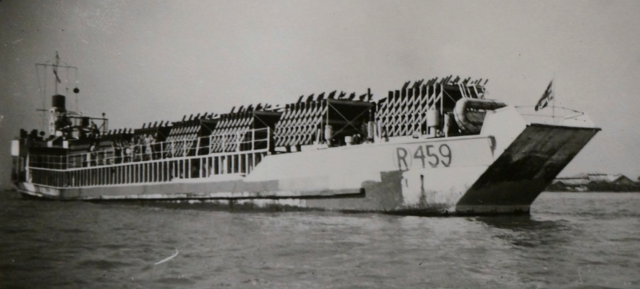
LCT(R) 459
LCT(R)(3) landing Craft, Tank (Rocket) Mk.III
Based on the LCT(3), fitted with a false deck and carrying 1044 5-in rockets or 936 in tropicalized versions (late war far east versions). Displacement was 560 tonnes, complement 17-18. Original numbers were kept so they are integrated in regular LCT(3) lists. A single one was lost in action.
LCG(L): British Amphibious Gunnery support
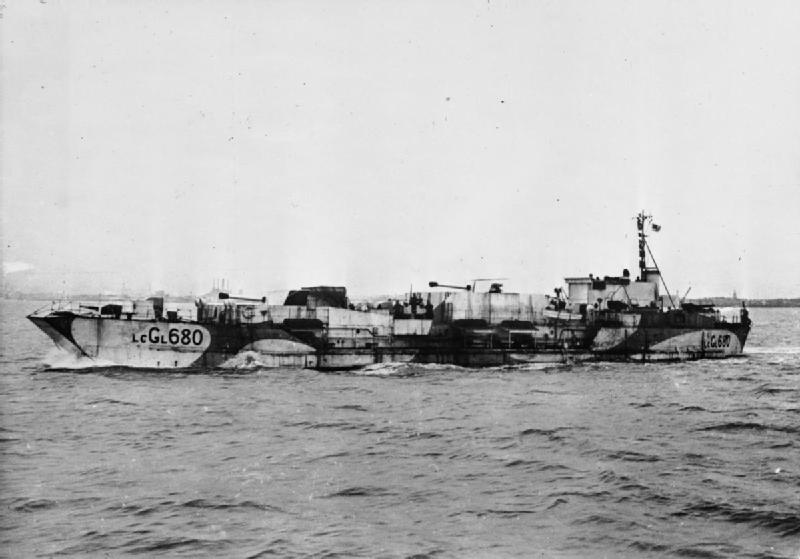
LCG(L) 680
LCG(L)(3) class landing crafts, gun (large) Mk.III
These were diesel engine LCT(3) converted as gunboats, displacing 500 tonnes loaded. Three retained their original numbers, and 26 were so converted. They carried surplus destroyer guns and AA for close defence. N°1 to 20 had two masked 4.7 in QF Mark IX and N°21, 22, 26, 424, 426 and 449 had two single 4.7 in BL, and all had two to four 20 mm Oerlikon guns, a complement of 45-48. The USN appreciated the type as well and four were lent to them, N°4, 424, 426 and 449. Four were lost in operations.
LCG(L)(4) class landing crafts, gun (large) Mk.IV
Regular LCT(4) converted as gunboats, ten of them. They retained their formed LCT numbers and were heavily modified: Two 4.7 in BL guns under masks mounted on their own platforms in tandem, the aft one higher up and protected by lightly armored steel walls against shrapnells. In addition they had seven 20 mm AA guns, they displaced 570 tonnes, and complement was 47-48. The ships concerned by this conversion were N°680, 681, 687, 764, 811, 831, 893, 939, 1007 and 1062. Two were also lent to the US Navy and war losses were three vessels.

LCG(L) Mark IV – Atlas Ed. Profile
LCG(M)(1) class landing craft, Gun (medium) Mk.I (1944)
These were common support vessels, armed with field artillery for shore bombardment and close support, a few miles inland. They originated from John Brown’s design in 1944 and were approved and launched this year, a hundred ships in all. The idea was to bring field artillery and gunners that can be later towed to short and follow the bridgehead development, while the ships were converted for other duties. They carried only two field guns, either the well-known 25-pdr howitzer or longer range 17-pdr, plus two standard AA guns. The guns were in protected “turrets”, échelonned forward and the ballasts could be flooded in order to ground these in a stable diring position. N°101 and 102 were lost in action.
-A LCG(M) Mark II version was ordered in 1945 for the far east, but they saw no service. The serie comprised the 501-524 with also either 25-pdr (four), the only one apparently completed.
-In addition a rocket launching conversion called LS(R) was also attempted, and numbered 1-30 but only the prototype was completed in 1945. She carried 50 4-in rockets.
Specifications LCT(8):
Displacement: 810 tonnes loaded
Dimensions: 68.6 x 11.58 x 1.46 m
Machinery: Two shafts Paxman diesels, 1760 bhp, 11.9 knots, fuel 22,600 gallons
Armament: 3x 20 mm AA guns, 22 crew, eight 30 tonnes tanks, 42 troops
Light Landing Crafts
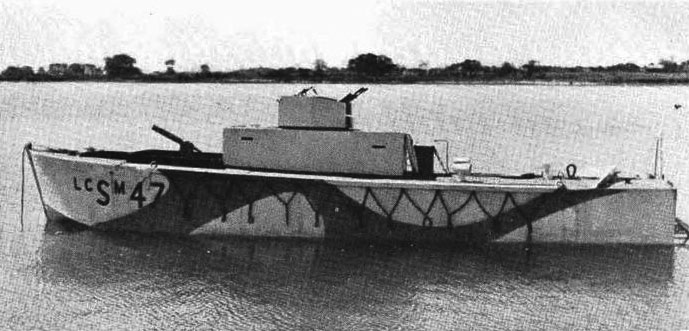
LCS(M)(3) class. Extract from osprey-Atlas.
LCA class landing crafts
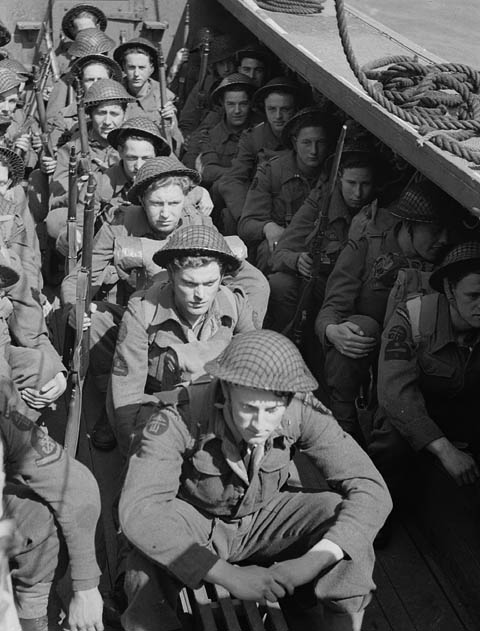
RN Beach Commandos from the 529th Flotilla, onboard an LCA. This was during an exercise off the coast of England, 9 May 1944. Due its low freeboard, they stayed seated to avoid exposure to enemy fire and shrapnell on their way to the shore.
With 2030 built, these were the main British infantry landing crafts during the war. Their philosophy was quite different from American boats. Their denomination was for “Landing Craft Assault”. They were light and essentially designed to shuttle and ferry troops from assault ships to the shore. The assault ships transported them (see above), or alternatively LCP, LCV or more rarely the heavier and larger LCM. Contrary to US equivalents, they were lighter, with lower walls, engines at the rear and small cabin for the pilot at the front-left, and a ramp. These were wooden vessel for greater production and like US boats, not using stategic materials.
Their genesis dated back from a 1938 request from the Inter-Service Training and Development Centre (ISTDC) at Fort Cumberland. Basic specifications were that these would weight no more than ten long tons to be lifted by passenger liner davits. It was to be shallow-draft and carry up to 31 men (a platoon) or five assault engineers or signallers. They were designed to beach at eighteen inches of water and a quick unloading procedure setup.
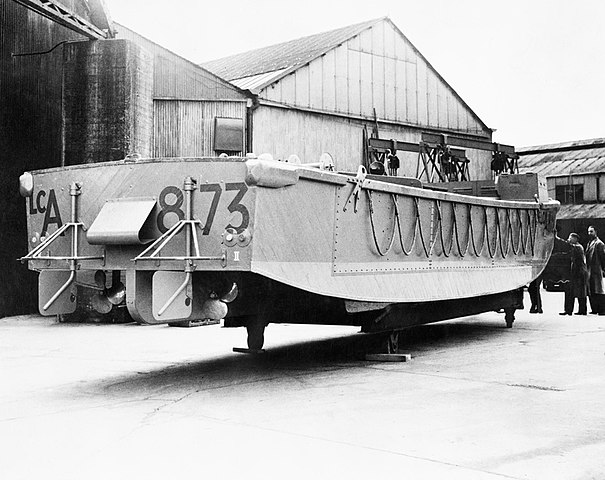
Newly completed LCA ready for launching in 1942
Soon the Director of Naval Construction (DNC) was approached but due to priorities later the design passed to the Board of Trade. Maritime architect. Mr. Fleming of Liverpool was proposed and started work on the new design. His initial plans were ready by November 1938 and approved. A wooden mock-up was built in the shed of Portsmouth dockyard and trials started. The DNC contacted three companies for production and only Thornycroft was able to submit a solid blueprint in 48h and therefore won the competition. J. S. White of Cowes started the first prototype, and in eight weeks she was trialled on the Clyde. However the first Fleming LCA appeared very noisy (but fast): The metal hull served as an amplifier for the two 120 hp Chrysler engines. This was bad for surprise. It was also difficult to armour the sides, due to rounded sections while the Birmabright alloy used for the plates presented quality defects. Thornycroft own design hull was made of mahogany, extraordinarily sturdy and flexible enough, but relatively costly and rare. Eventually two 65 hp Ford V8 engines were tried on this second prototyoe, as they were much quieter while noise-breaking measures were taken.
Eventually both designs were competitevly tested in Langstone Harbour, landing a platoon of Royal Marines. It seemed obvious quickly that if the Fleming boat presented advantages, the metallic hull and noisy engines made the CNT prefer the Thornycroft design, modified to take features of the Fleming boat: After its double-diagonal mahogany hull, the hull was lowered and the profile modified to produce a small bow wave, making it suitable for a surprise landing and commando operations. It was also decided to replace if needed the external Mahogany hull by armoured plates and make the narrow ramp larger.
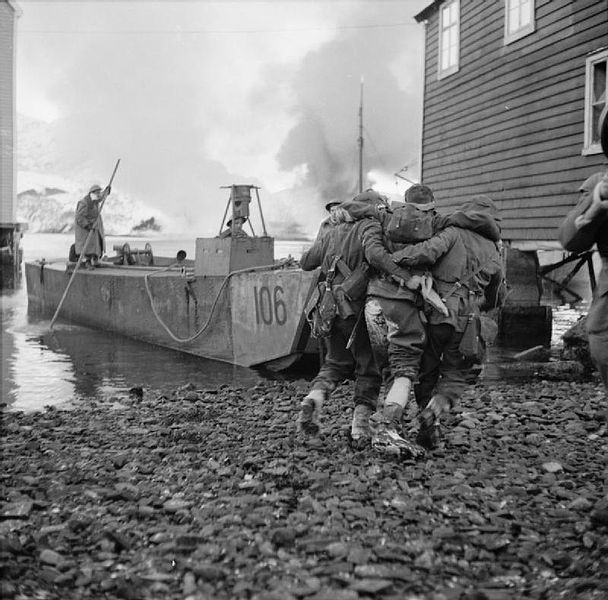
LCA ready to carry back to the ship a wounded man helped by its comrades during operation Archery in Norway, December 1941.
For the production boat, the keel was made from Canadian rock elm, shaped by steam. The sides were plated with 10 lb. DIHT armour plates over D1 steel. For buoyancy, lower hull’s bulkheads were packed with 30 cubic feet (850 L) of Onazote buoyant material in the forward section, in the sides and aft. The central well section was fitted with three benches, centre, port and starboard. Therefore three lines of infantry were waiting seated, their heads low enough. The best protected were the sides troops, which head was protected by the flank’s armoured recess overhead. At the bow, this well was closed by a pair of forward-opening armour-plate doors, seated on the folding ramp which acted as a wave deflector. It was handled by gravity and a simple arrangement of pulleys and wire. No risk for power failure; When down, it took two to three minutes to have all men out. There was also a Lewis gun shelter port for close defense and cover. Aft, port was the steering shelter, complete with a telegraph for medium range com, and voice pipe to the stoker at aft. The pilot had a featherspray control lever and fold-up seat, and in some cases a compass.
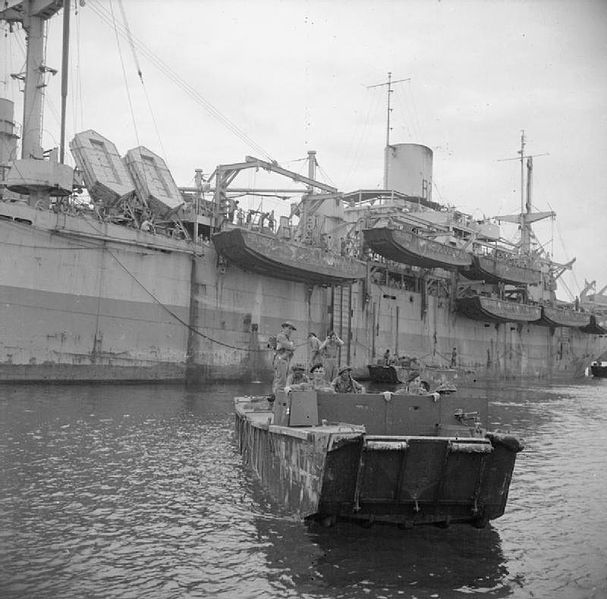
LCA leaving HMS Rocksand for the island of Nancowry, Nicobar Islands, October 1945 (far east campaign).
Propulsion consisted in two sheltered and noise-covered Ford V8 engines which drove 19 in x 14 in 2-bladed propellers. The craft carried 64 imperial gallons (290 l), enough for a few back-and forth shuttles. Steering consisted in twin rudders and wires. Both the engines and montage allowed the crafts to be perfectly silent at low speeds to 25 yards, and they can handle 3 to 5 ft (0.91 to 1.52 m) waves, but due to their low profile, foundered in 6 ft (1.8 m) waves (like in D-Day). Although a bit underpowered and slow in heavy weather, they were reasonably good sea boats.
Production:
18 LCAs were ordered from Thornycroft by April 1939 as a preserie for further tests; Eight more with propulsion changes, using Parsons reductors and then Scripps conversion, with finally ordered 30 by the admiralty in March 1940. In all, 2,030 LCAs were built from 1940 to 1944. Production was constant during the war, with some changes: The coxswain’s position was moved forward, starboard side. Also some had direction finding antenna loops, Danforth anchors, and some layout changes such as the mooring bits, chocks, cleats, fairleads, and fuel caps and fitting of lifelines looped along the hullside. Most were left in factory light grey-blue livery, and some camouflaged, usually with a dark grey-blue wavy pattern. Large identification numbers were painted in white forward.
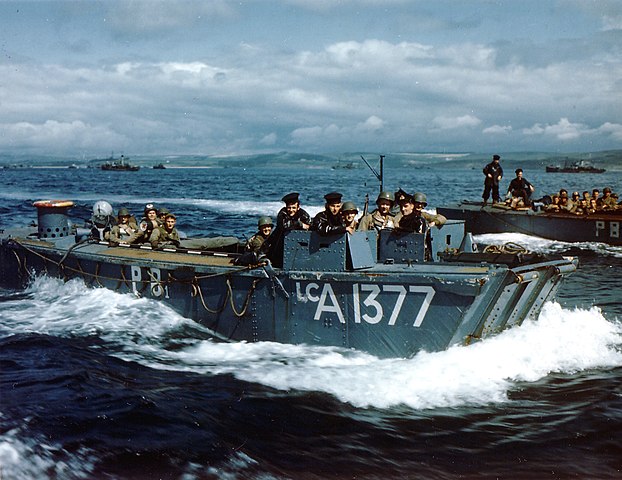
British LCA 1377, preparations for the Normandy invasion, carrying US troops, circa May-June 1944 (cc)
Variants:
-The LCA had a shore support variant called LCS(M), with a 4-in smoke mortar in the well for concealment and optional heavy machine guns.
-A second variant was called LCA(HR) (or “Hedgerow”), carrying a Hedgehog spigot mortar. It was quite heavy and many were foundered en route in heavy weather. It fired 24 bombs arranged in four rows of six, like the Navy system for ASW purposes. Range was limited to 250 yards forward. The system was alternative to Hobart’s funnies for clearing beach minefields and obstacles. This system proved quite successful, used at Salerno and in Normandy.
-“flying hose” LCA: Another “funny”, this craft was fitted with a mine-clearing line charge device, a coil of hose attached to a rocket, and nitroglycerine ws pumped into it. It was an experimental kind of giant inflatable “bangalore torpedo”, never tried in combat. The system however was used by the 79th Armoured Division (“Congers”) on Universal Carriers.
-The US Rangers version used at Pointe du Hoc had 3×2 rocket tubes, firing tine grapnels, and no central bench.
-Orther experimental versions were the LCA(OC) (to clear foreshore obstructions), LCA(FT) (flamethrower) and LCA(CDL) (light projector). They were replaced by transformed tanks for this tasks. There was even a LCA(Bakery), to provide bread on the shore.
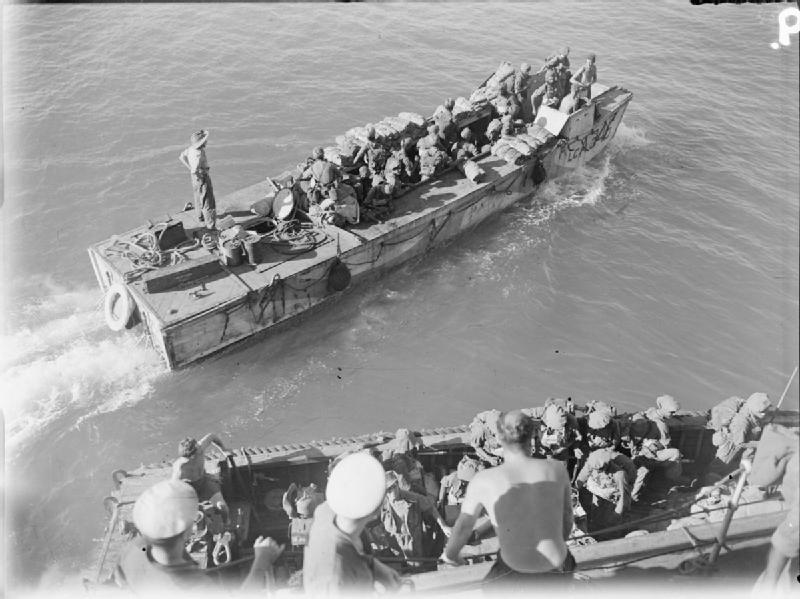
Indian troops from the cruiser HMS Kenya onboard LCA 346 en route to replace Royal Marines South of Ramree, Burma.
Specificatons LCA:
Displacement: 9.144 tonnes loaded, 4 tons load
Dimensions: 12.6 x 3 x 0.5-0.7 m
Machinery: Two Ford petrol V8, 65 bhp, 6-10 knots, range 80 miles
Armament: 2x Bren guns, 4 crew, 363 kgs or 35 troops
Armor: 6.4 mm sides and rear – 19 mm front.
LCS(M)
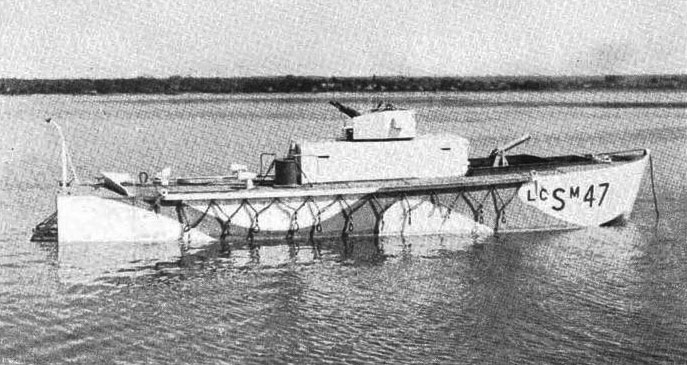
The Landing Craft, Support (Mortar) was the main light support version of the LCA. The idea was to add a spigot mortar at the front, protected by armoured plates and a small casemate behind, which had an optional roof turret. Indeed there were sub-variants showing no turret roof at all but a Browning M2HB .5 cal. instead. One was photographed on 6 June 1944 with this arrangement, named PA13-27. There is no evidence a heavier gun such as an oerlikon or Polsten has been installed.
-The forward smoke mortar was mounted on a pivot for 360° traverse and had a 90° elevation. This was a 4.2 inches standard army mortar converted for this use. It could fire standard grenades if needed.
-The open gun turret was tailored for either a twin 0.5 in Vickers HMGs (1932). The Vickers HMG were liquid-cooled and already used on many Royal Navy ships in quad tandem mounts and some land vehicles converted to AA. The IMW model clearly shows a twin Vickers arrangement.
-Alternative Besa 15mm HMG was already used on the British light Tanks Mark VI and Humber armoured cars for example. It was compact and had more punch than the Vickers model and US M2HB but based on the 1936 Czechoslovak ZB-53 as a scaled-up version of the 0.303 Besa LMG (ZB-60), it had a 25-round link belt and weighted 57 kg (125 lb). It was introduced in June 1940.
-The LCS(M) received DIHT armored plating on the hull sides, deck, bulkheads, conning tower and ammunition hoists.
-Other specs are identical to the regular LCA (see below).
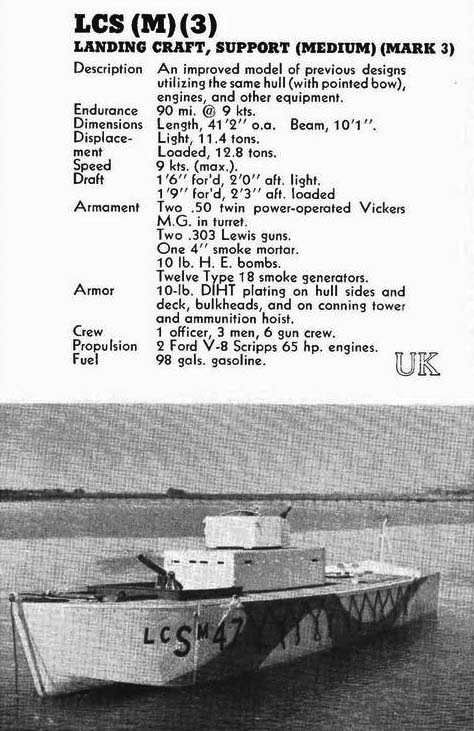
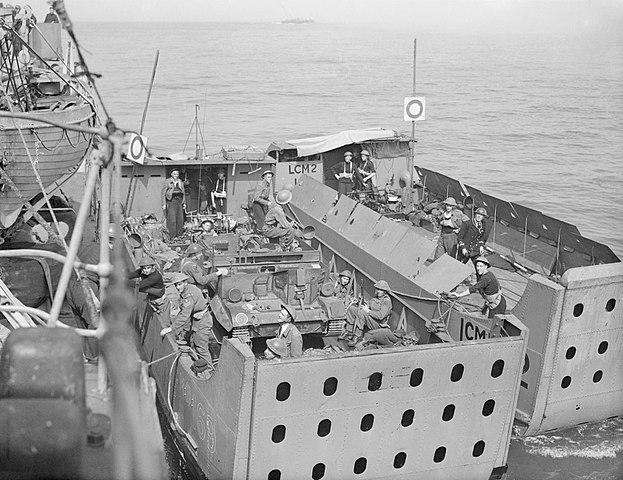
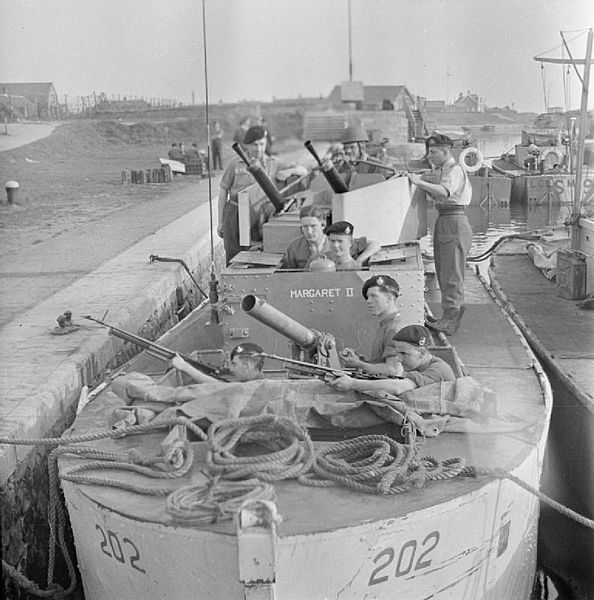
Forward view of “Margaret II”, an LCS(M) of the Royal Marines, Force T in South West Holland for attacks from the German-held island of Schouwen.
LCP family class landing crafts (1941)
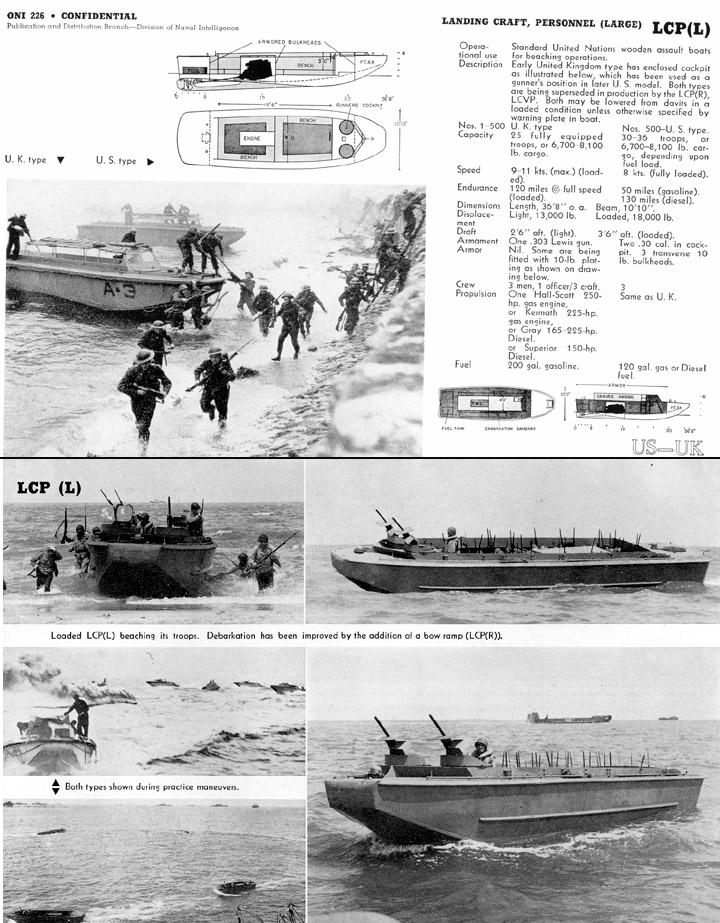
ONI recoignition datasheet for the LCP(L)
The Landing Craft, Personnel were a parralel development to the LCA, introduced from 1941. Four main versions existed, built in UK, Commonwealth and the US. Around 420 British LCP(2) and LCP(S) were built by the British until 1943. They were completed by circa 1,200 LCP(L) and (R) built in the US and transferred via lend-lease until 1943.
LCP(2): First British-built version of the wooden LCP – Little to no info available (yet), equivalent to the LCP.
LCP(S): Should be for Landing Craft Personal (Support), but again, little info available, nor photo.
LCP(L)
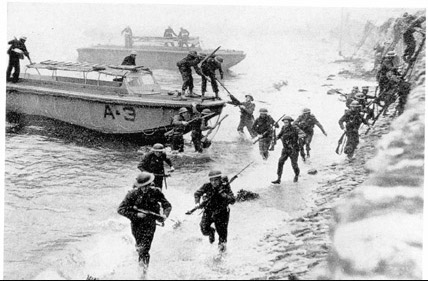
The LCP(L) for Landing Craft Personnel (Large) was made of pine planks and plywood, fitted with some armor plate.
This derived from the US prototype from Eureka Tug-Boat Company of New Orleans, Louisiana. A wooden boat, low, without ramp and with a central well for 30 troops. It was ordered specifically as a light, short range shallow draught vessels made on non-strategic materials for mass-production inside the US in as many facilities as possible. It derived from lighter boats used to travel in the immense network of the Bayou.
The British version featured a covered roof over the well, right behind the forward superstructure. It was either covered by a tarpaulin or some more rigid structure.
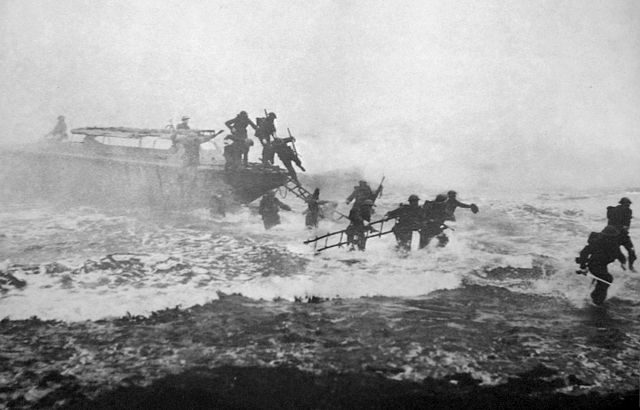
Famous photo of “Mad Jack” Churchill leading a training charge with his broadsword, from an LCP(L). He was responsible for the only kill in WW2 with a longbow.
LCP(R)
The LCP(R) for Landing Craft, Personnel (Ramped) were a development of the LCPL, replaced the solid bow by a small ramp, and eliminated the necessity to jump over the sides under enemy fire. The LCVP started to replace them after 1942, built all over the US. A total of 413 were transferred under Lend-Lease and some 30% retained saw service with the Marines in the Pacific campaign, up to 1945. Higgins would patent later the LCVP.
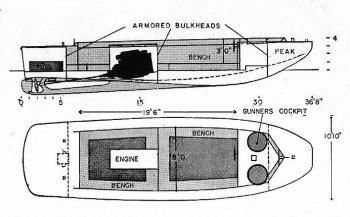
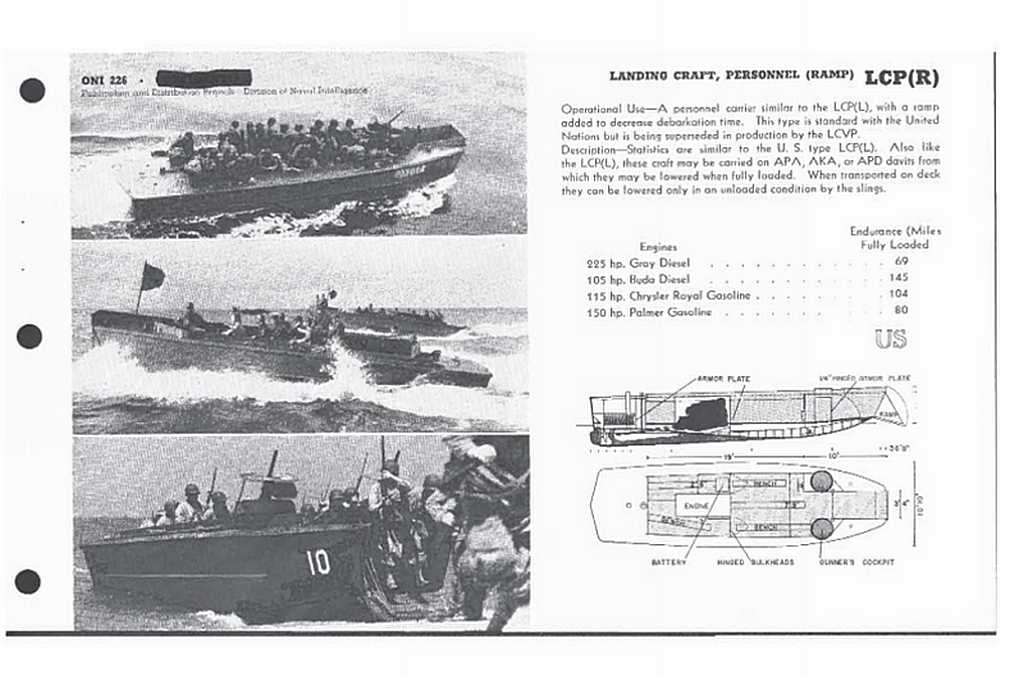
ONI-recoignition plates of the LCP(R).
LCV/LCV(P) class landing crafts
These were US-built wooden landg crafts. Landing Craft Vehicle (and personnel). The proverbial landing craft of WW2. From the staggering total production, only around 700 were transferred to the British Navy via lend-lease in 1942-43. They were 11 to 11.5 tonnes, 36 feets in lenght, with high walls and ramp, and carried 36 troops of a 3 tonnes vehicle, a lorry or jeep. Of course this model will be studied in detail in the upcoming WW2 section.
LCM class landing crafts
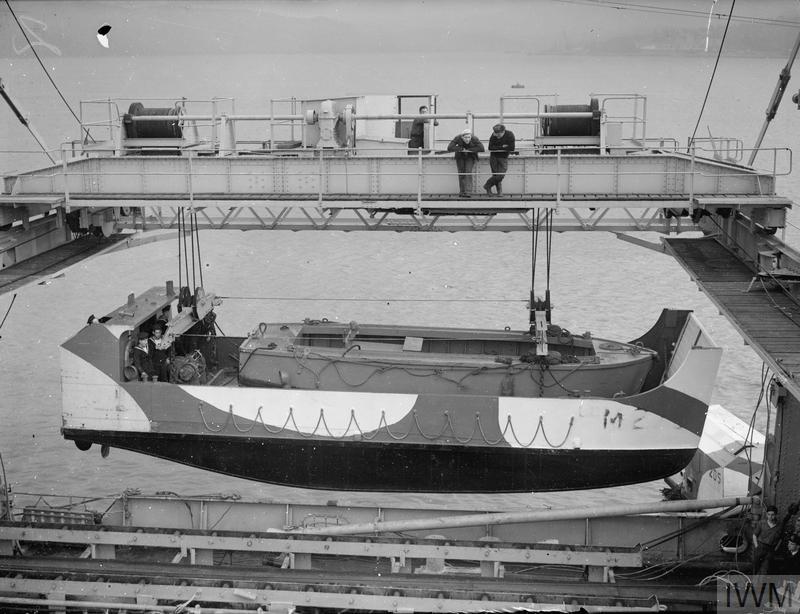
Landing Craft (mechanized): The standard universal landing craft able to carry vehicles and troops, either the standard 3-tonnes lorry or two jeeps, or a light tank and 100 troops. Three main variants were built, in UK and in the US, transferred via lend-lease, in all 750 British-built and and 650 US-built so 1,400 in all. There were three versions produced over the years
LCM(1) (1941)

LCM(1) during the Dieppe Raid.
This was a 36 tonnes, 48.5 feets overall boat with high walls and a ramp. The driver and engine compartments were at the rear. The Landing Craft, Mechanised Mark 1 had a covered cabin at the rear which maked it recoignisable and well adapted to the north European climate, and walls ending with a curved bow framing the ramp. The latter was pierced by openings to make it lighter. It made also improvized portholes for firing but made the deck wet in heavy weather.
It derived from a request by the Inter-Service Training and Development Centre ‘s (ISTDC) in 1938 and was developed by John I. Thornycroft Ltd. February 1940 saw the end of the trials and acceptation soon followed.
The LCM(1) was propelled by two Thornycroft 60 bhp petrol engines, but production models used Chrysler in-line, 6-cylinder Crown petrol engines (60 bhp each at 3,200rpm) and later 115 bhp with 250.6 cubic inches pistons. Exhausts went through two sets of vents port and starboard. They carried a 16-tonnes tank or lighter vehicles and up to 100 equipped infantrymen, three platoons.
Production went on until 1944. 132 were list in action until 1945, so about 1/5.
Top speed was 10 kt (light) down to 6 kt (loaded), with a range of 50–80 miles. The crew consisted in six men, the coxswain, stoker, four seamen, and one officer per group of three boats.
Armament was light, only two Lewis Guns and armour comprised 10 lb. DIHT (3/4″) plates at the front and on bulkheads and sides 7.8 lb. DIHT (1/4″) plating.
Variant: The LCM(4)
A close development, the LCM(4) was developed in 1943-1944, and seventy-seven were built. Completely identical only the pontoon diverged by having special bilge pumps and ballast tanks to alter trim and increase stability when partially loaded.
First use in action was in Norway, where a LCM(1) carried to shore a French 13-ton Hotchkiss H39 supporting the 13th Demi-Brigade (13e DBLE) on the beach at Bjerkvik, near Navrik. later General Antoine Béthouart directed another raid behind German lines using these boats. The capacity of carryiong light tank proved instrumental in allied success in this operation, by combining LCM, MLCs, and LCAs. Later one LCM was also used at Dinkirk.
These were used mostly for commando operations, in North Africa and Indian Ocean as well, used by RCN and RIN troops and commandos. The US army depended also on these crafts in their early landings (Operation Torch and following).
LCM(3)
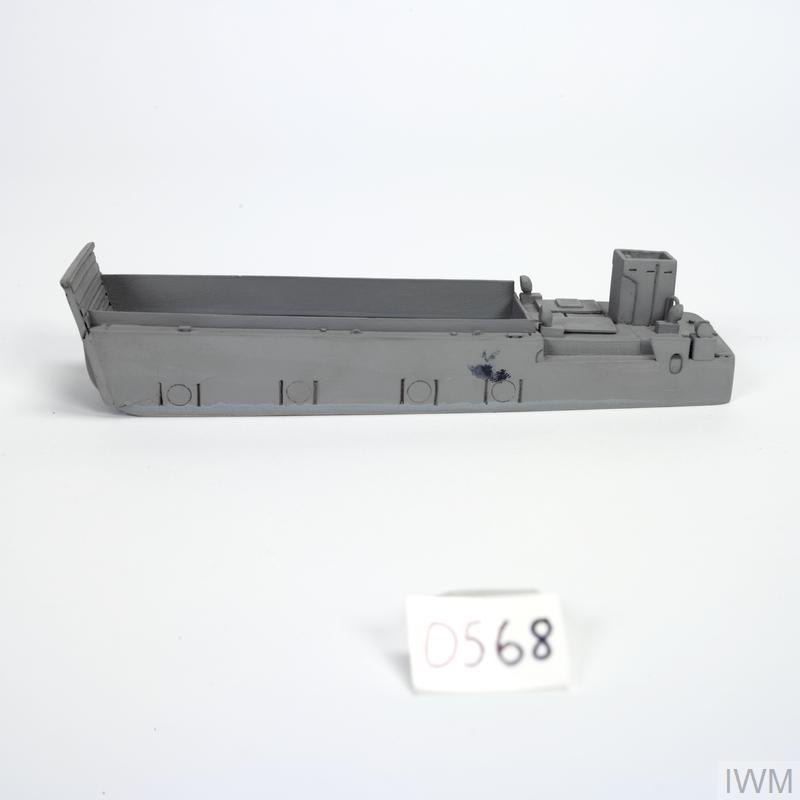
The Landing Ship, Mechanized, Mark III was not an evolution of the Mark I but the American version of the latter. In all 650 US-built were transferred via lend-lease.
Specifications
-Dimensions: Length: 50 feets, Displacement: 52 tonnes full, 22 light.
-Crew of four: 1 coxwain, 1 engineer, 2 crew members.
-Propulsion: 2 Diesel engines, 110-225 hp Top speed 11 knots, 8 knots loaded
-Transport capacity: 30-ton tank, 60 equipped soldiers.
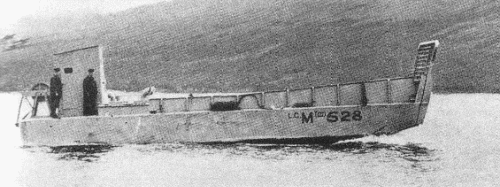
LCM(3) on trials, LCM 528 (MoD)
LCM(7)
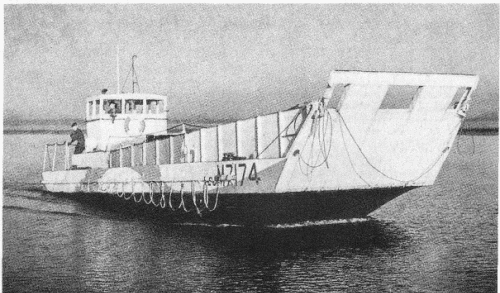
LCM(7) M7174 (MoD)
The largest of all, 60 feets long overall. Same arrangement as the former, with a small cabin at the rear.
It was reinforced and large enough to carry a single 40 tonnes tank such as the Sherman M4. US-built but a small number, 150, were British-built in 1943-44.
Specifications
Displacement: 63 tonnes full, 28 light
Dimensions: 18.4m x 4.90m x 1.13m (60 feets long)
Powerplant: 2 shafts Hudson Invader diesels, 290 bhp, 11 knots, 1.7 tonnes fuel oil, 150 nm.
Armament: 2x 12.7 mm .5 cal Browning M2HB
Capacity: Single 35/40t tank or 100 troops, complement 7.



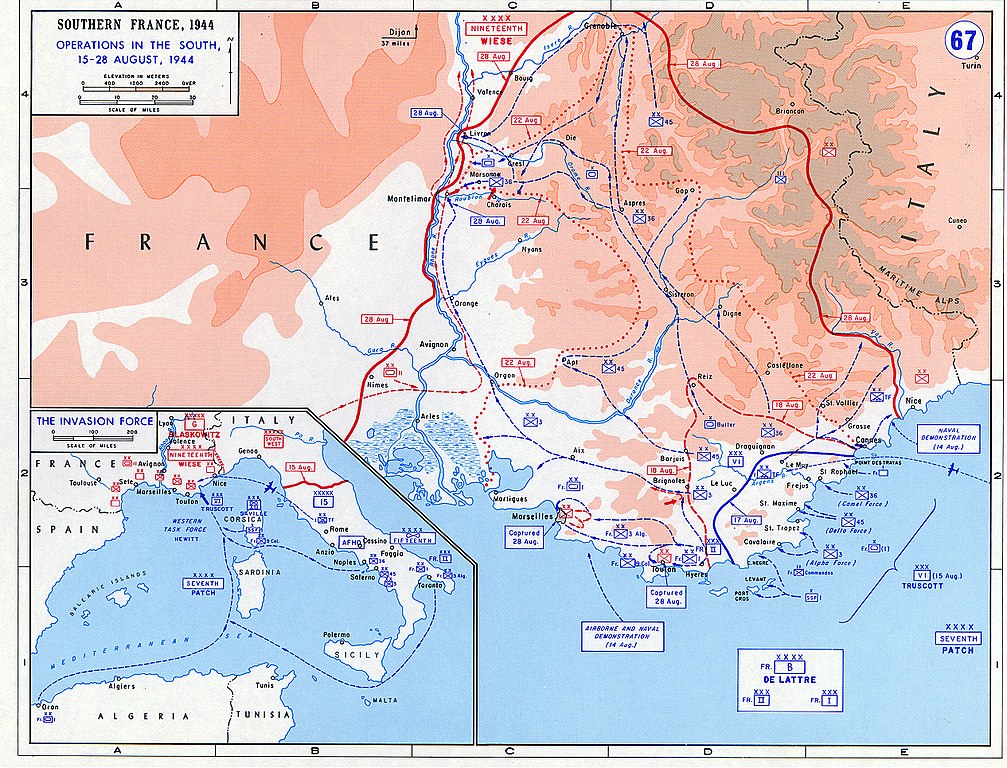
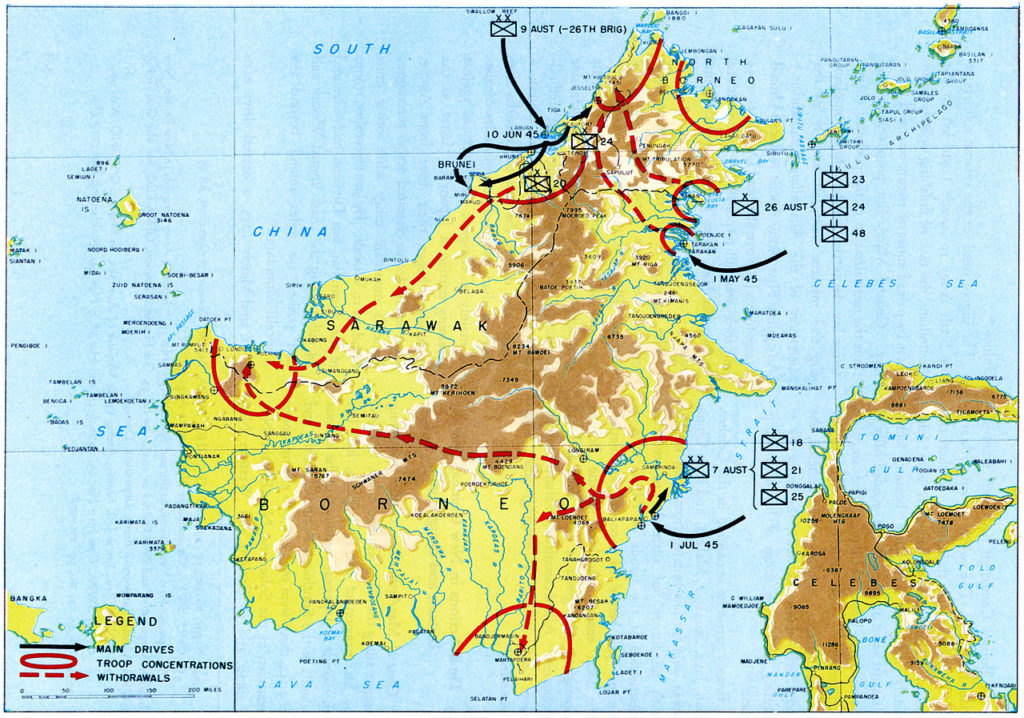
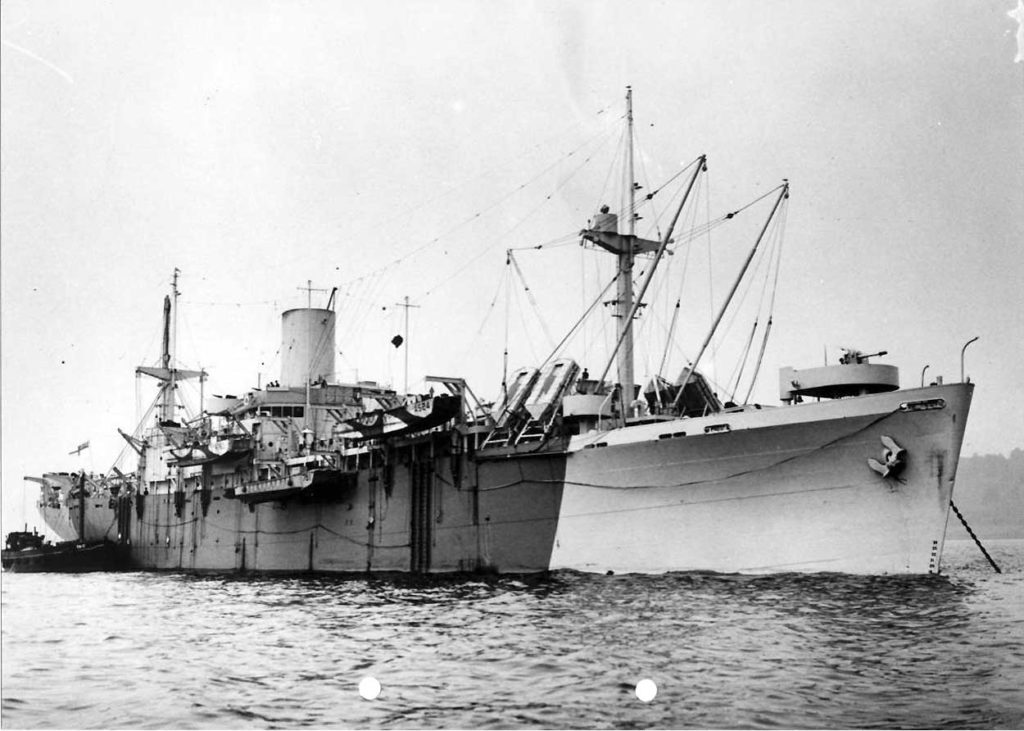
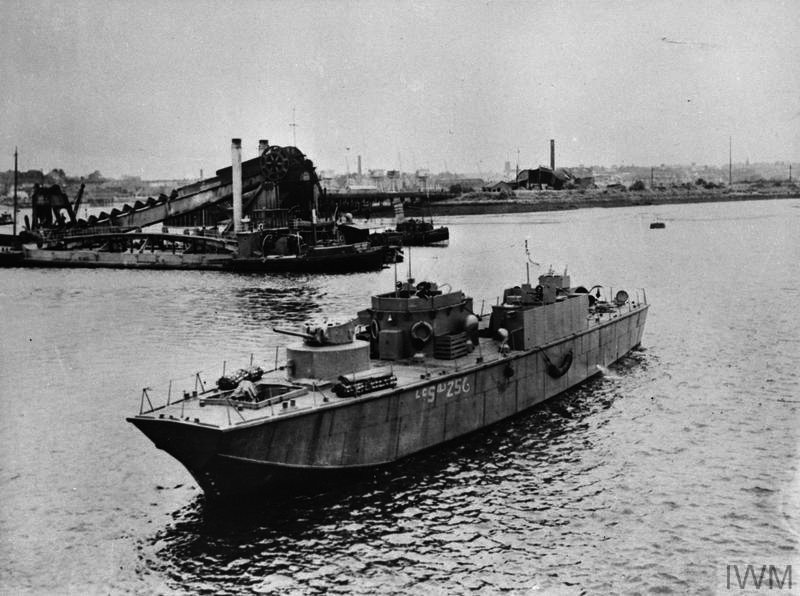
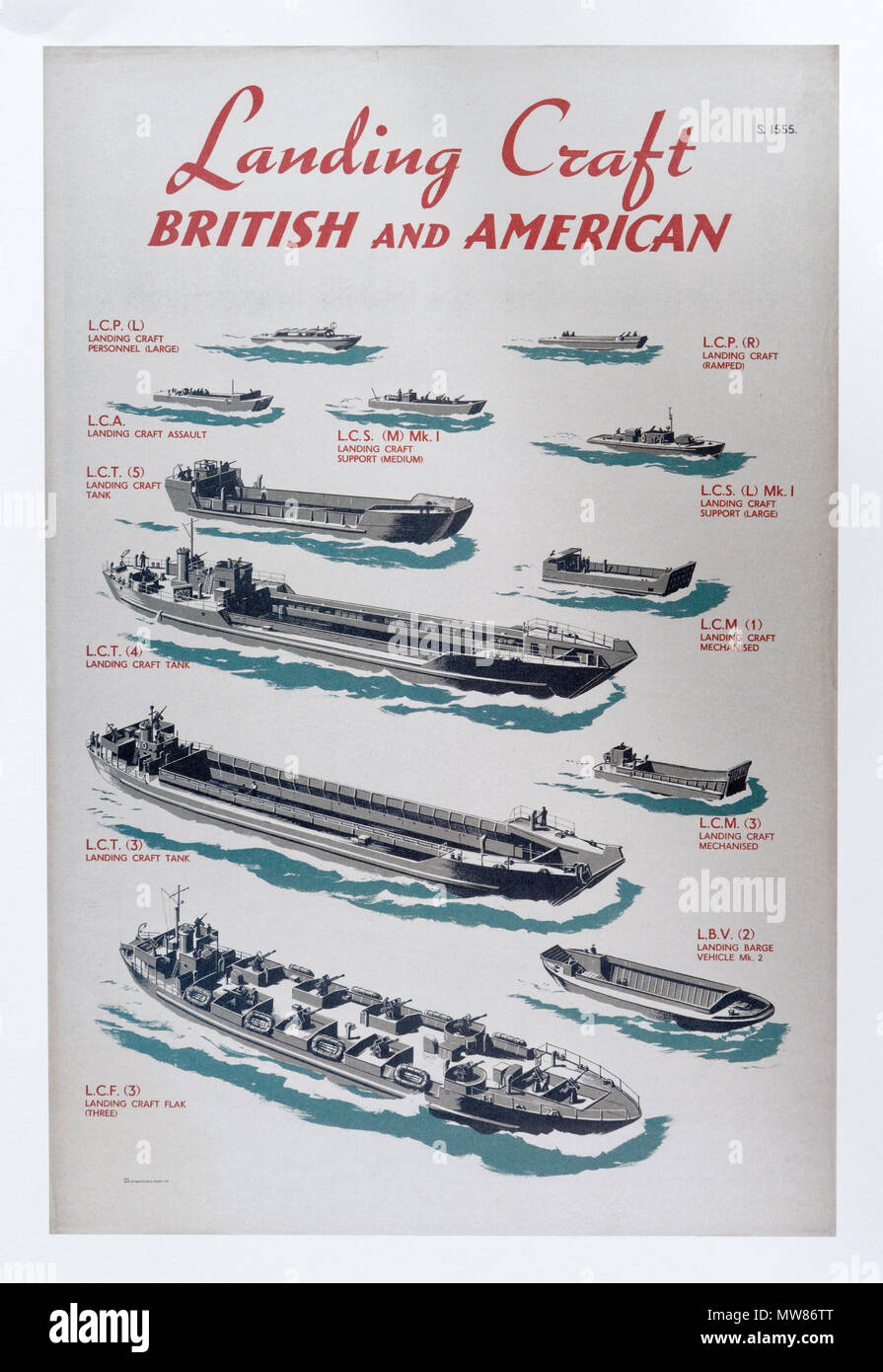
 Latest Facebook Entry -
Latest Facebook Entry -  X(Tweeter) Naval Encyclopedia's deck archive
X(Tweeter) Naval Encyclopedia's deck archive Instagram (@navalencyc)
Instagram (@navalencyc)





 French Navy
French Navy Royal Navy
Royal Navy Russian Navy
Russian Navy Armada Espanola
Armada Espanola Austrian Navy
Austrian Navy K.u.K. Kriegsmarine
K.u.K. Kriegsmarine Dansk Marine
Dansk Marine Nautiko Hellenon
Nautiko Hellenon Koninklije Marine 1870
Koninklije Marine 1870 Marinha do Brasil
Marinha do Brasil Osmanlı Donanması
Osmanlı Donanması Marina Do Peru
Marina Do Peru Marinha do Portugal
Marinha do Portugal Regia Marina 1870
Regia Marina 1870 Nihhon Kaigun 1870
Nihhon Kaigun 1870 Preußische Marine 1870
Preußische Marine 1870 Russkiy Flot 1870
Russkiy Flot 1870 Svenska marinen
Svenska marinen Søværnet
Søværnet Union Navy
Union Navy Confederate Navy
Confederate Navy Armada de Argentina
Armada de Argentina Imperial Chinese Navy
Imperial Chinese Navy Marinha do Portugal
Marinha do Portugal Mexico
Mexico Kaiserliche Marine
Kaiserliche Marine 1898 US Navy
1898 US Navy Sovietskiy Flot
Sovietskiy Flot Royal Canadian Navy
Royal Canadian Navy Royal Australian Navy
Royal Australian Navy RNZN Fleet
RNZN Fleet Chinese Navy 1937
Chinese Navy 1937 Kriegsmarine
Kriegsmarine Chilean Navy
Chilean Navy Danish Navy
Danish Navy Finnish Navy
Finnish Navy Hellenic Navy
Hellenic Navy Polish Navy
Polish Navy Romanian Navy
Romanian Navy Turkish Navy
Turkish Navy Royal Yugoslav Navy
Royal Yugoslav Navy Royal Thai Navy
Royal Thai Navy Minor Navies
Minor Navies Albania
Albania Austria
Austria Belgium
Belgium Columbia
Columbia Costa Rica
Costa Rica Cuba
Cuba Czechoslovakia
Czechoslovakia Dominican Republic
Dominican Republic Haiti
Haiti Hungary
Hungary Honduras
Honduras Estonia
Estonia Iceland
Iceland Eire
Eire Equador
Equador Iran
Iran Iraq
Iraq Latvia
Latvia Liberia
Liberia Lithuania
Lithuania Mandchukuo
Mandchukuo Morocco
Morocco Nicaragua
Nicaragua Persia
Persia San Salvador
San Salvador Sarawak
Sarawak Uruguay
Uruguay Venezuela
Venezuela Zanzibar
Zanzibar Warsaw Pact Navies
Warsaw Pact Navies Bulgaria
Bulgaria Hungary
Hungary

 Bundesmarine
Bundesmarine Dutch Navy
Dutch Navy Hellenic Navy
Hellenic Navy Marina Militare
Marina Militare Yugoslav Navy
Yugoslav Navy Chinese Navy
Chinese Navy Indian Navy
Indian Navy Indonesian Navy
Indonesian Navy JMSDF
JMSDF North Korean Navy
North Korean Navy Pakistani Navy
Pakistani Navy Philippines Navy
Philippines Navy ROKN
ROKN Rep. of Singapore Navy
Rep. of Singapore Navy Taiwanese Navy
Taiwanese Navy IDF Navy
IDF Navy Saudi Navy
Saudi Navy Royal New Zealand Navy
Royal New Zealand Navy Egyptian Navy
Egyptian Navy South African Navy
South African Navy






























 Ukrainian Navy
Ukrainian Navy dbodesign
dbodesign
In your article LSI(M/S) class landing ships, HMS Prince Philippe was sunk after a collision. Regards
Hello Rick, some confusion between Prince David and Philippe in Conways,, verified and fixed thanks !
In your otherwise excellent article on Landing Ships Infantry I did notice a very slight error. The article quotes “while the reste were sold to civil companies in 1946-47”.
The ships were returned to the Company that originally owned them but the ‘Leopold’ and ‘Philippe’ were paid for by the British Government and new ships rebuilt.
Regards
Thanks for the precision !
David
Thank you for this excellent and comprehensive article.
The Fairmile ‘H’ or Landing Craft Infantry (Small) was a small class and is usually overlooked. The 200th, 201st and 202nd Flotillas of the 1st LICI(S) Squadron did, however play a significant part in D-Day, landing the 1st Special Service Commando Brigade, under the command of Brigadier Lord Lovat DSO, MC, together with Nos 3, 6, 41 and 45 Commandos on Sword Beach and 4 Commando Brigade HQ and 48 RM Commando on Juno Beach. The squadron lost eight of the thirty-nine craft involved, and members of the squadron were awarded 6 Distinguished Service Crosses, 3 Distingished Service Medals and 17 Mentioned in Despatches (4 posthumous).
Surviving craft played a significant role in the punishing Walcheren raid.
I think they can be said to have been rather more successful than they are usually given credit for, although their contribution, in the scale of things was relatively small.
My father served in HM LCI(S) 502, landing on D-Day and leaving for his next appointment in December 1944, which was, ironically, to an LCI(L).
Hello Bruce, and thank you.
Thanks also for this generous comment, and personal connection !
I hope to cover all specific types of Landing Crafts individually in dedicated posts in the future, they deserves it.
Could anyone advise me regarding the existence of an “LST Colombo”? Not HMS Colombo, believe a landing craft, an LST. Understand some seamen from HMS Venetia were seconded? Assume after Venetia was damaged at Boulogne? Or during Boulogne action? Or were they drafted to LST Colombo after sinking of Venetia, Oct 19 1940? Sorry, I know this is confused… Believe ‘Colombo’ was torpedoed and the serviceman I’m interested in got ashore to France, whereupon he was captured and ended up in Stalag VIII-B. Any informed insight greatly appreciated!
Sorry Guy, i have long lists of landing crafts and ships but it’s listed nowhere. Perhaps an auxiliary converted vessel ? If someone else in this threat could answer, this would be much appreciated.
Hi, my father served in the Marines during WW2 he spent most of his time on LCF 29. Do you have any information on this please. Love to know where and when it was involved in the war.
Hi Rigby, no info “at home” but the closest clue of their career i could find was there https://www.combinedops.com/LCF.htm
Good search !
David
Hello, would anyone be able to assist me with the locations of these landing craft please?
LCT 2304 November 1942
LCT 2226 November to December 1942
LCT 501 February to March 1943
LCT 128 February 1944
LCT 838 April 1944
LCT 1330 July to September 1944
LCI (L) 217 February to March 1945
271 LCI (L) flotilla May to August 1945
LCI (L) 183 October to November 1945
271 LCI (L) December 1945
A LCI (L) squadron January to March 1946
All help appreciated to make sense of my grandad’s service as a stoker. Thank you.
Hi Catherine, sorry i don’t have the detailed logs for all specific Landing ships/Crafts of WW2.
many thanks for your reply